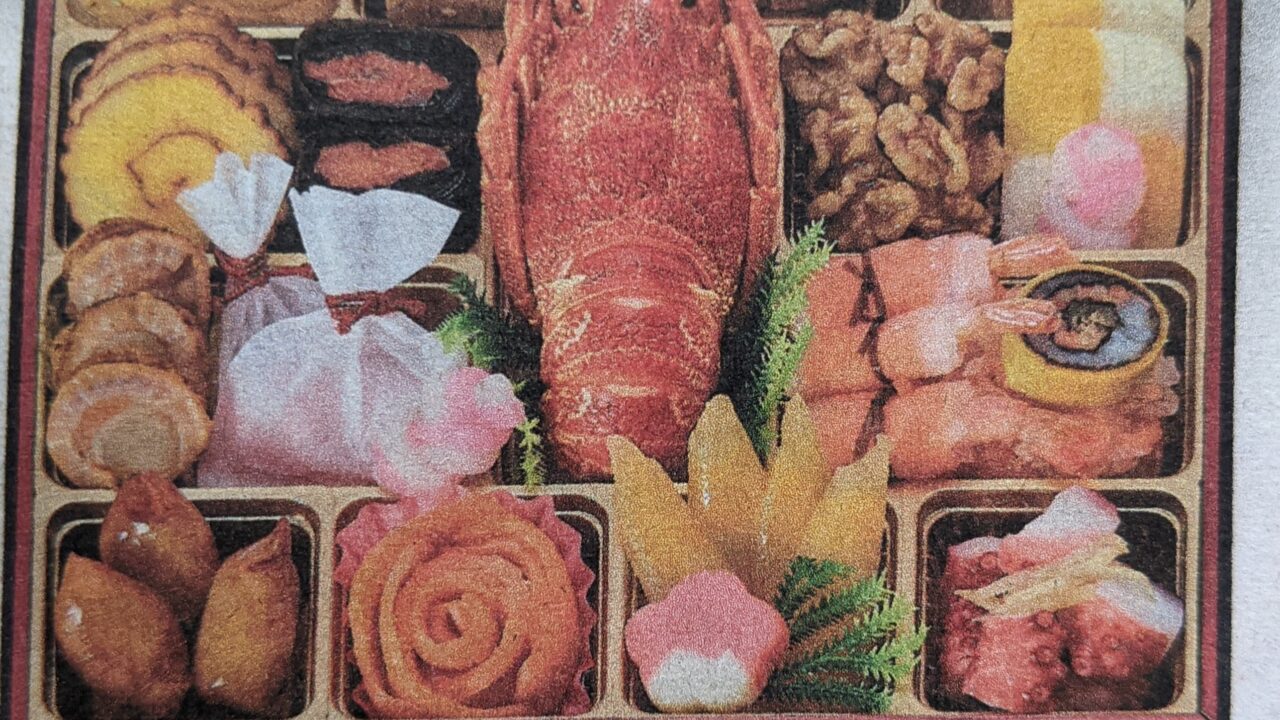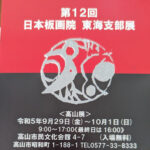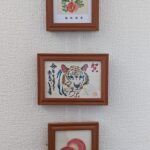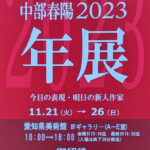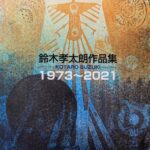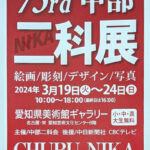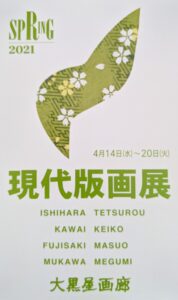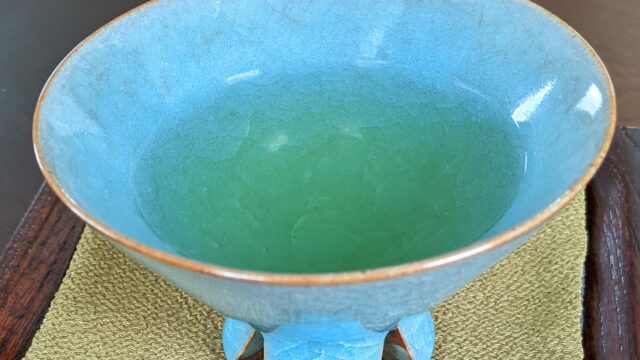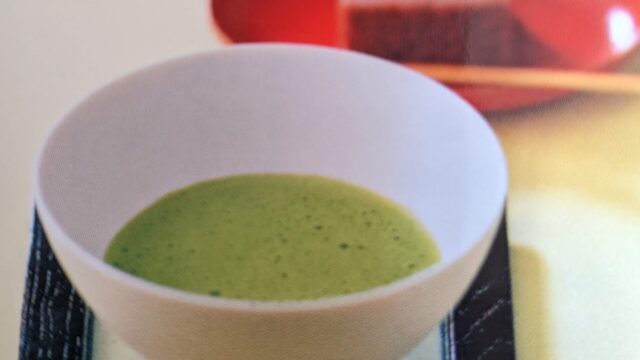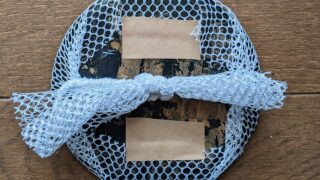2013年日本食は、無形文化遺産としての地位をユネスコの5番目の国として取り上げられました。
Japanese food was the fifth time for UNESCO to give a country’s food its cultural heritage status in 2013.
既に登録されているものとして、仏蘭西料理・地中海料理・メキシコ料理そしてトルコ料理があります。
French, Mediterranean, Mexican, and Turkish food are already on the list.
伝統的日本料理「和食」
写真:ミニ懐石料理(mini-kaiseki)
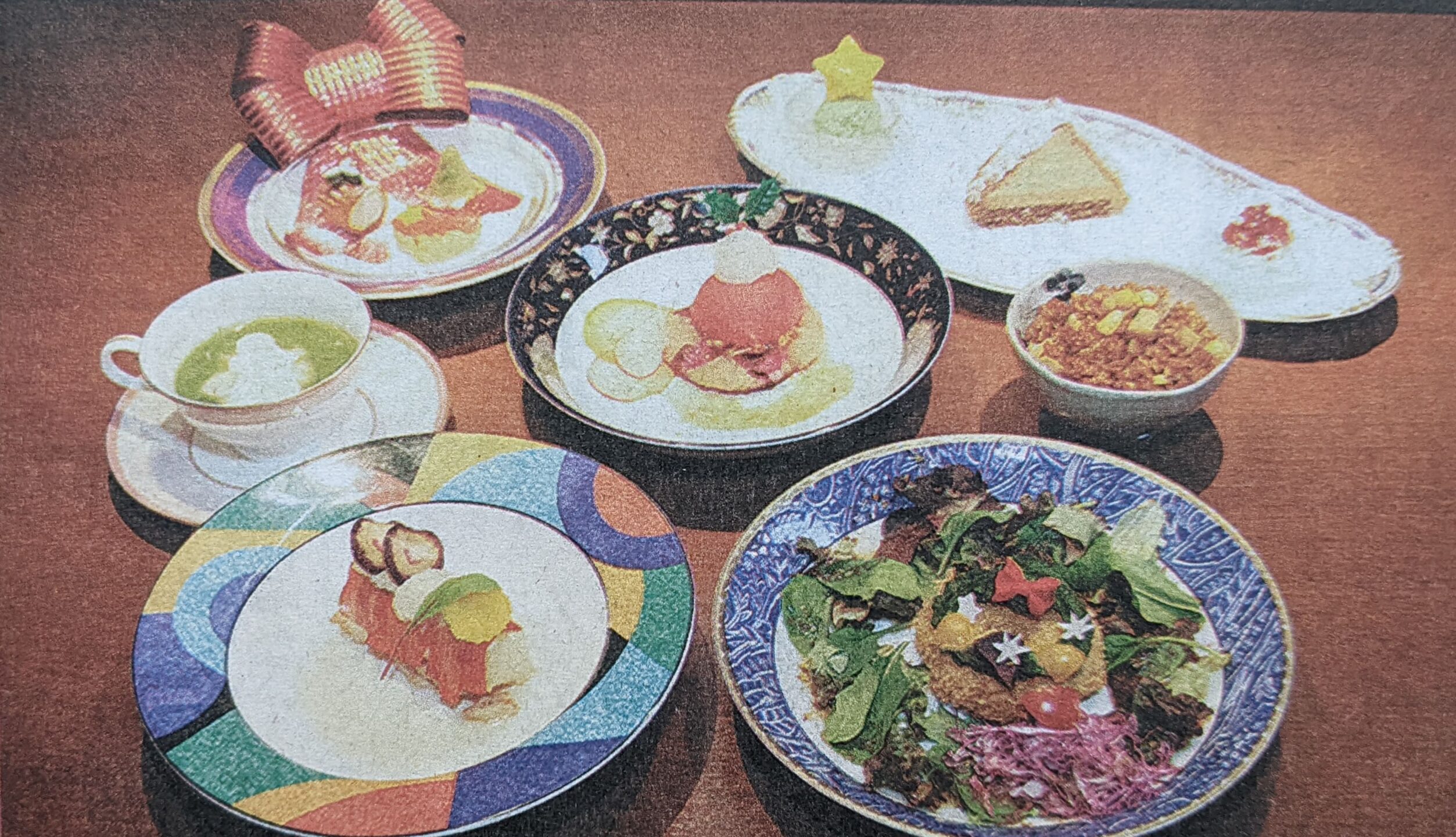
写真:dainty and refined Japanese dishes each served individually
伝統的日本料理は「和食」と呼ばれています。
Traditional Japanese food is called “Washoku”.
伝統的日本料理「和食」は、その変化に富んでいることで知られています。
It is very famous for its variety.
「和食」の例を挙げると、寿司(お米に生魚を乗せる)からラーメン・天ぷらそしてスキヤキまで及び様々です。
It ranges from sushi (row fish on rice) to ramen noodles, tempura and Sukiyaki.
日本側は文化的観点から、一つか二つの有名な料理だけではなく、すべてを登録して欲しいと願った。
Japanese Agency for Cultural Affairs said it wants to put all of its food on the list not just one or two famous dishes.
政府は、「伝統的日本料理は芸術的に表現され提供されること自体が特別である」と言っている。
The agency said Japanese food is special because of its artistic presentation.
その事は独特な食材を使って表現される。
It also uses unique ingredients.
伝統的日本料理では、たくさんの皿が四季を祝う重要な役割をする。
Many dishes are important because they celebrate the four seasons.
正月料理(the New Year’s cooking)
正月(Shougatu=the New Year)
・・・一年の一番目の月。また、松の内(1/1~1/7)を言う。
January、 the New Year。 the New Year Week.
元旦(gantan)=1月1日。
New Year’s Day。 the first day of the year。
三が日=正月の元旦・2日・3日。
the first three days of the New Year。
おせち料理(Osechi=New Year’s dishes)
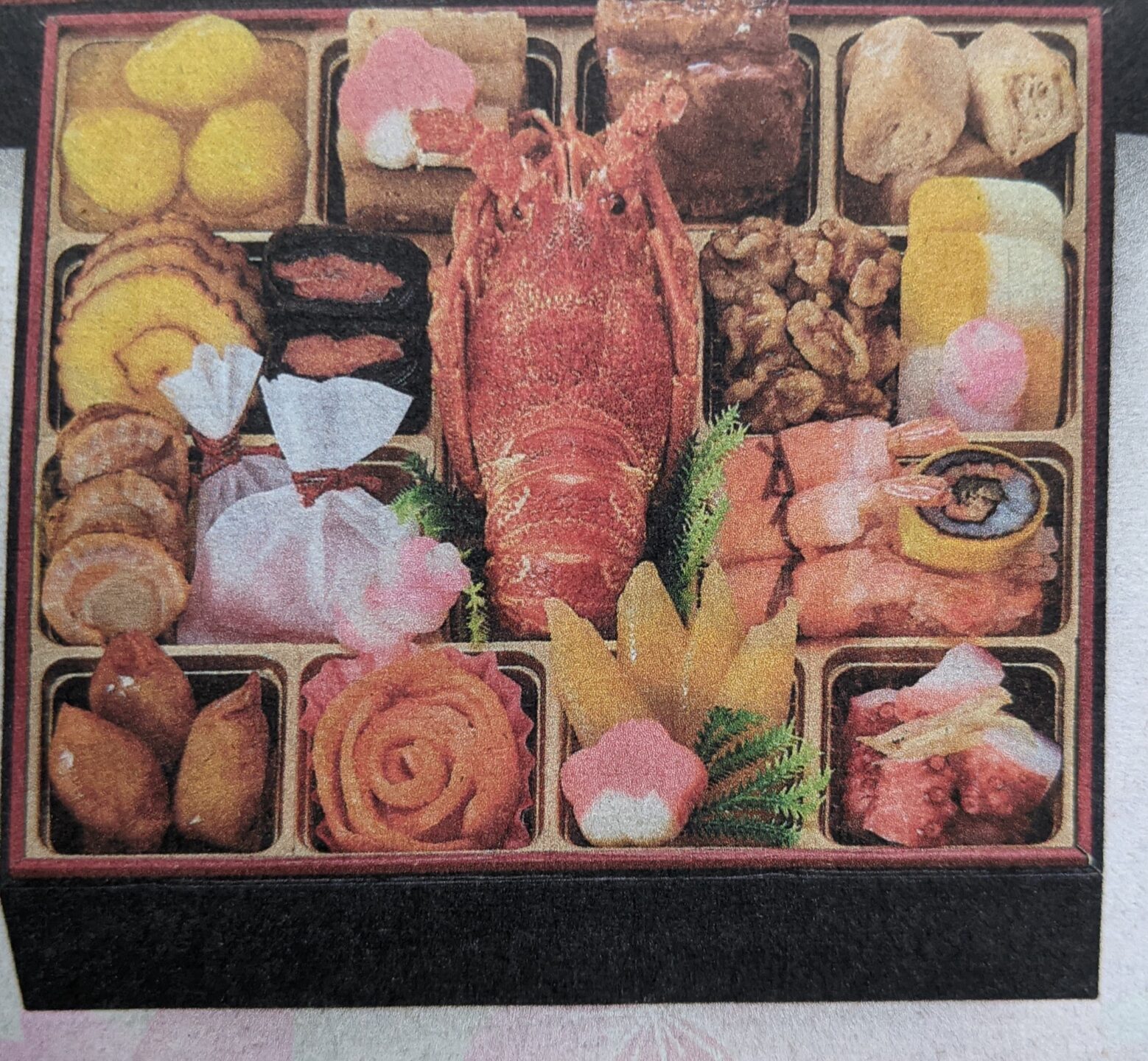
写真:おせち料理(a lot of ingredients)
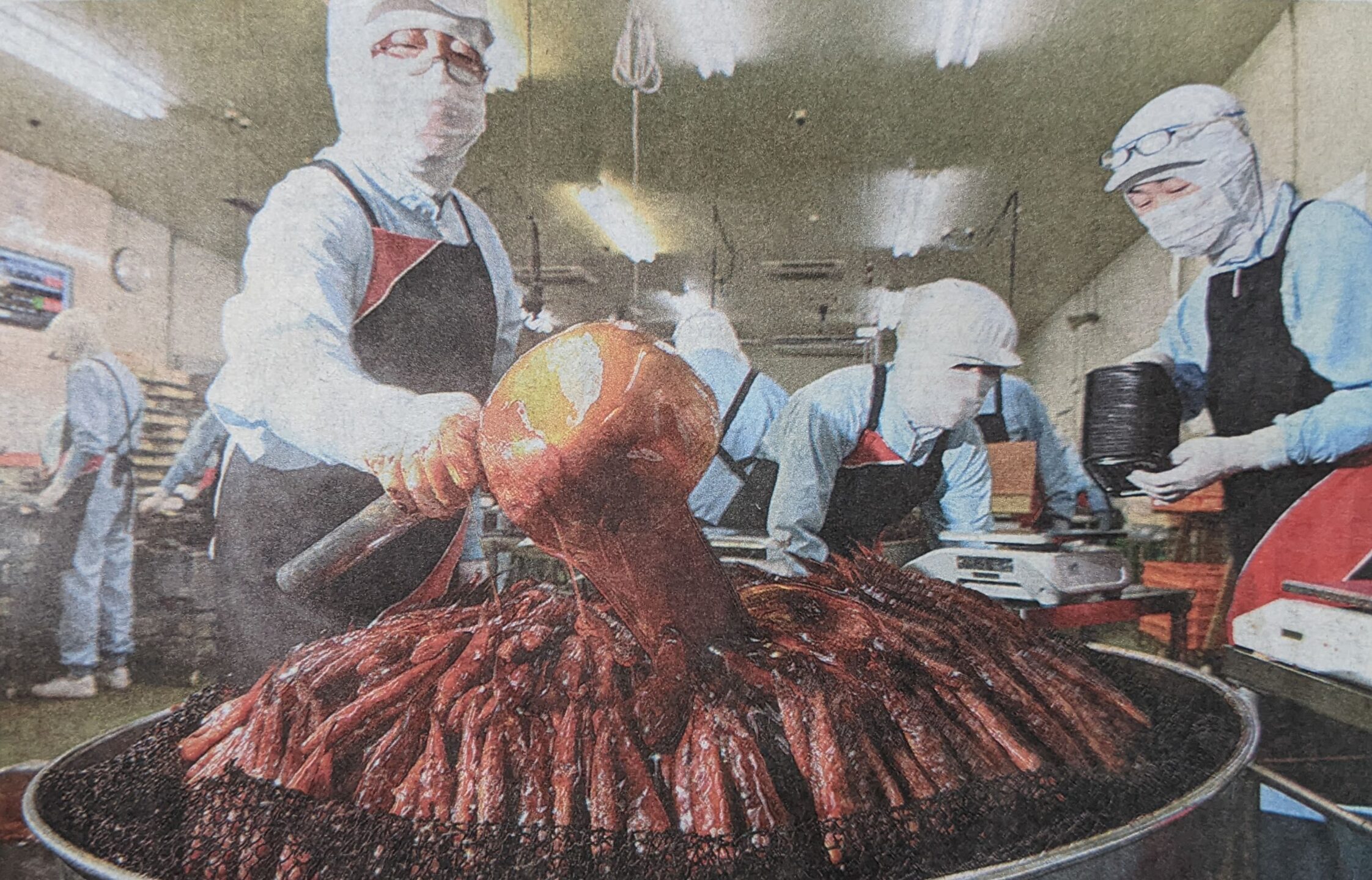 写真:ハゼの甘露煮(Gobies simmered in sweetened soy sauce)
写真:ハゼの甘露煮(Gobies simmered in sweetened soy sauce)
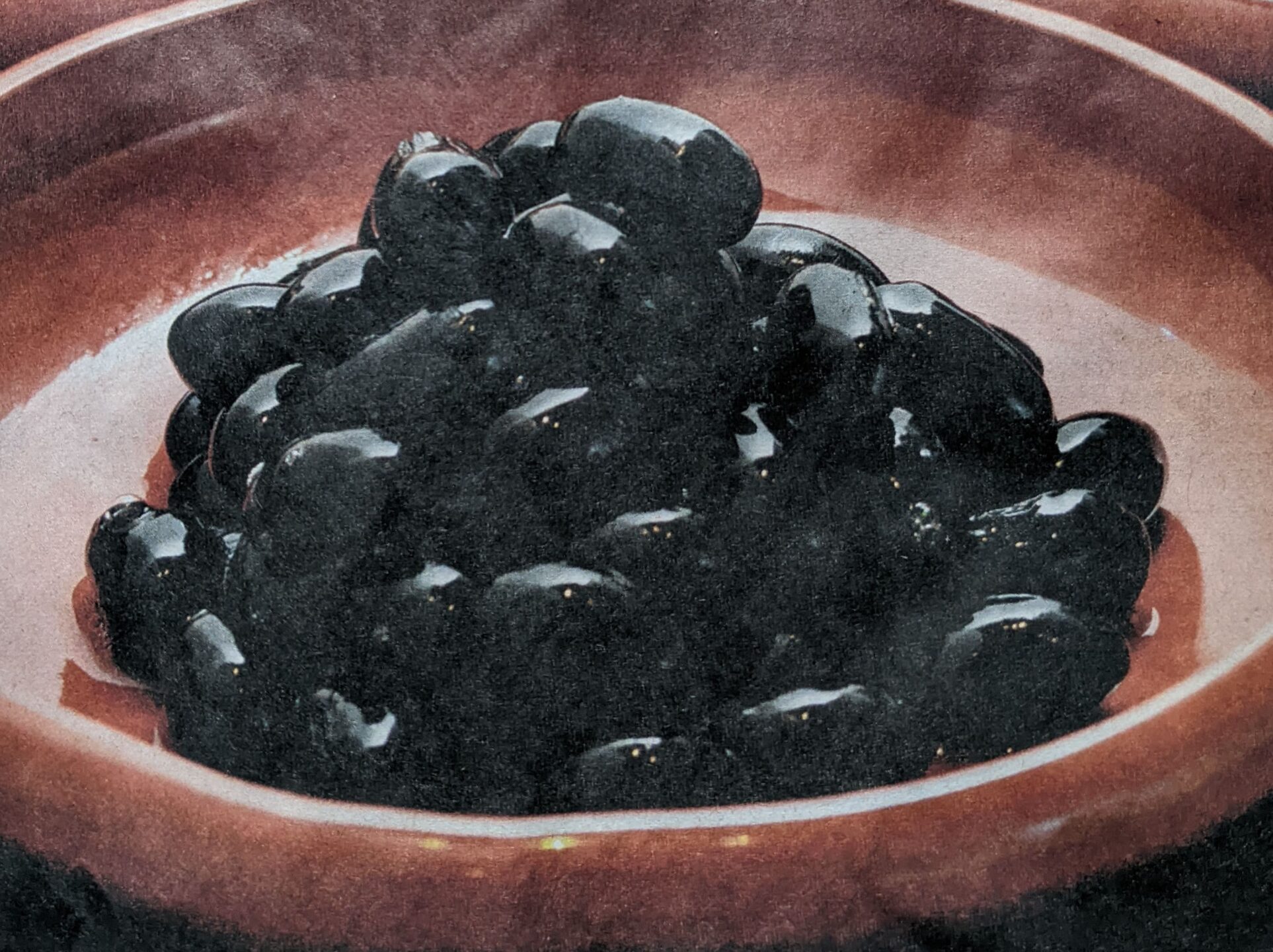
写真:丹波の黒豆(Black beans from Tanba)
おせち料理は年末までに作ります。
We make Osechi until the end of the year.
・・・正月に食べるため、たくさんの野菜の種類と魚介類を醤油スープで煮しめます。
Many kind of vegetables and seafood stewed in a soy-flavored broth, which is eaten on new year’s day.
しかし最近は普通の家庭でおせちを作ることは困難です。
Recently it is hard to make Osechi at ordinary home.
もち(mochi=rice cake)
・・・餅は、年末までに蒸された米を臼でつき作ります。
We pound boiled rice in a mortar to make rice cakes until the end of the year.
餅には、丸餅(Maru-mochi )と切り餅(kiri-mochi)があります。
Speaking of mochi, there are Round-mochi and Cut-mochi.
餅は、食べる前に焼きます。
Rice cake is baked before eating.
焼くと堅い餅がやわらかくなります。
When you bake it, the hard rice cake becomes soft.
ぞうに(Zoni= soup with rice cake)
Zoni=お正月に食べられる、餅を入れたスープです。
Zoni is soup with rice cakes that can be eaten on New Year’s Day.
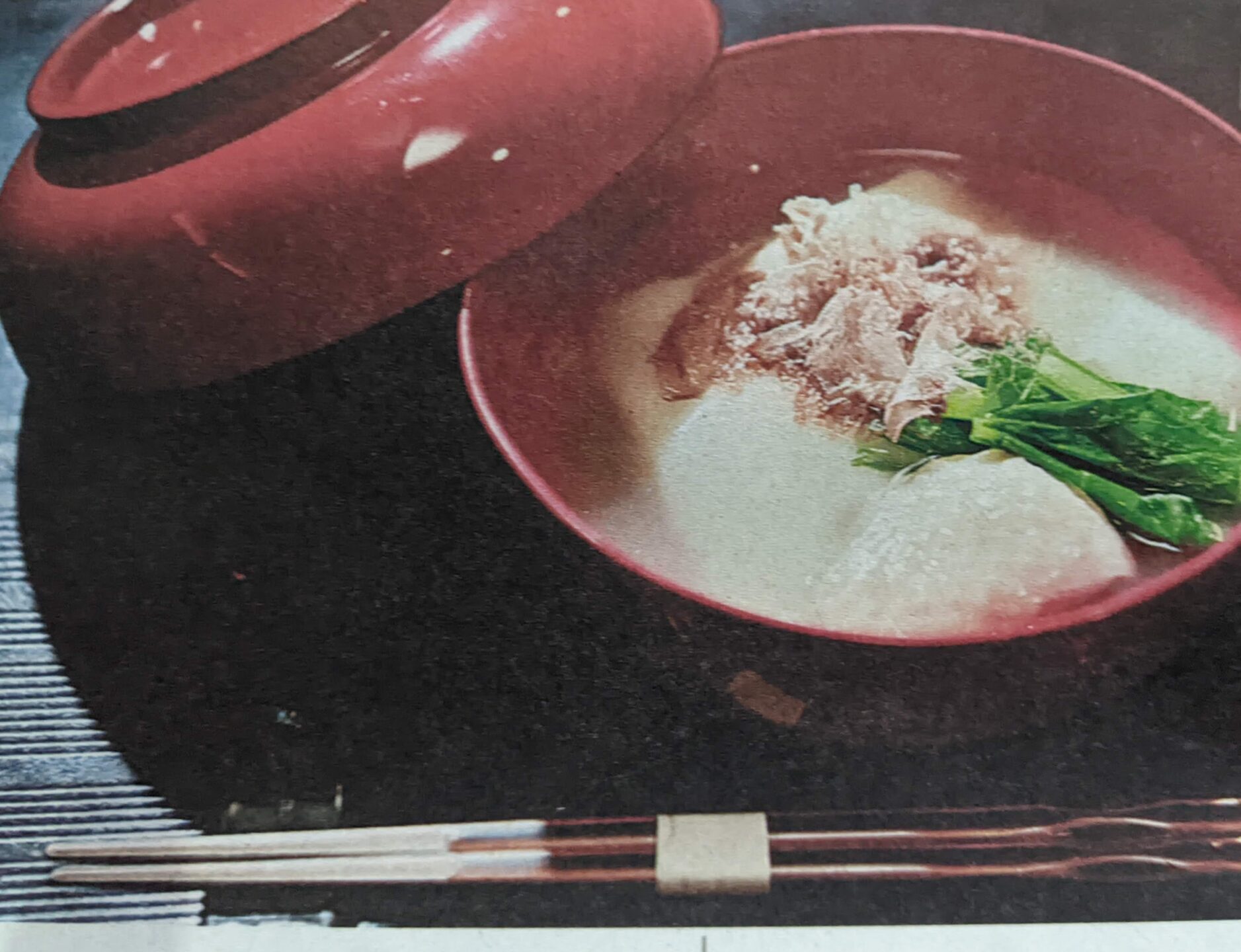 写真:ぞうに(Zoni)、most simple style in Chubu region of Japan.
写真:ぞうに(Zoni)、most simple style in Chubu region of Japan.
しるこ(Shiruko=sweet adzuki soup)
・・・しるこは、餅のかけらを入れた甘いアズキ汁です。
Shiruko is a sweet adzuki(red-been) soup with pieces of rice cake.
おせち料理・餅・雑煮・しるこ・正月料理を代表します。
Osechi-ryori, Mochi, Zoni, Shiruko, they are meal that represent New Year’s cooking.
関連する風習(traditional customs)
屠蘇(Toso-sake)
屠蘇散を屠蘇袋に入れ、酒・みりんに浸して飲む。一年の邪気を払い、寿命を延ばすという。
Toso-sake will remove evil spirits and extend the life.
日本では平安時代から行われる、正月の祝儀として飲んでいます。
We have been drinking it since the Heian period as a New Year’s celebration.
花もち(Hana-mochi=flower rice cake)
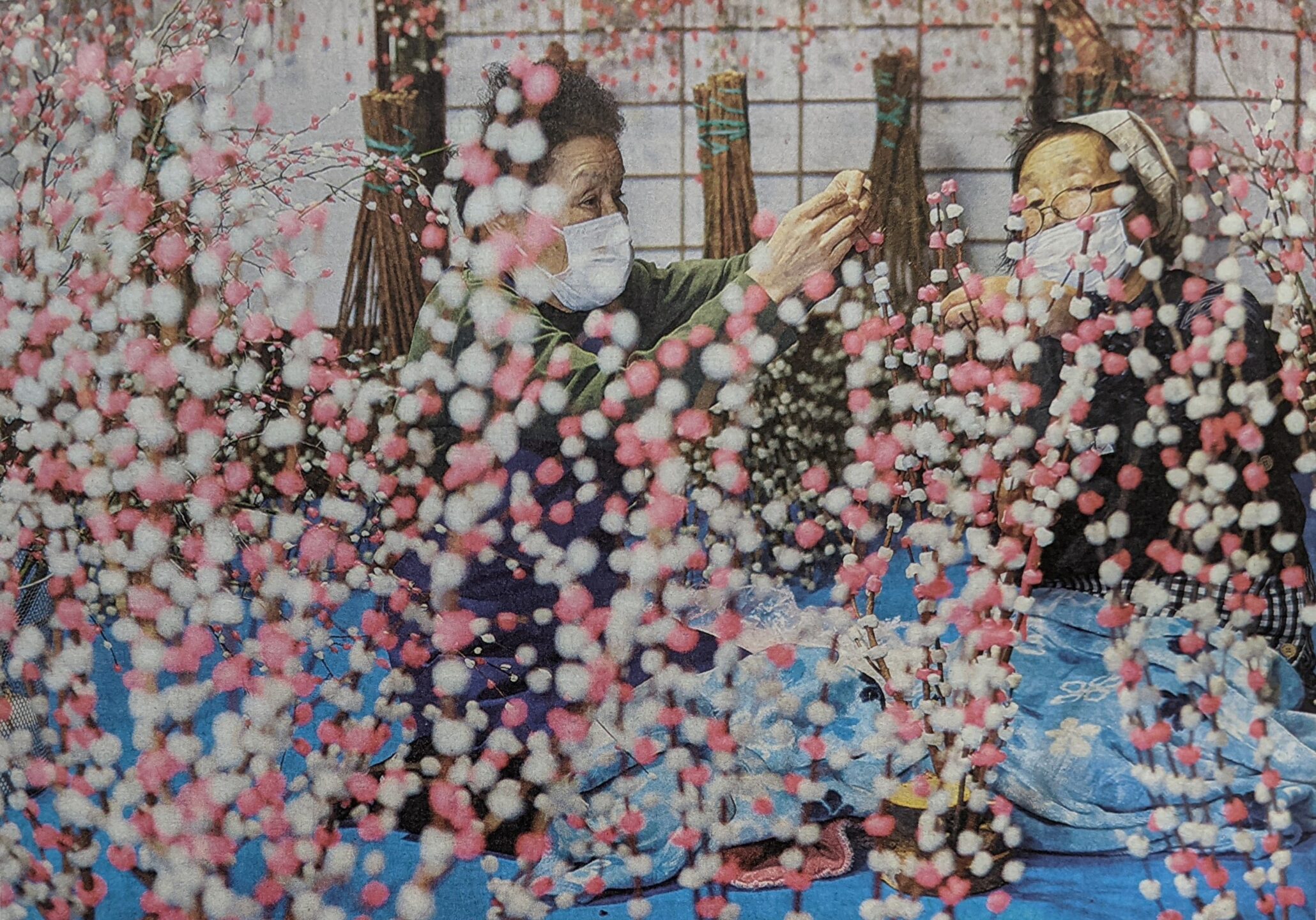
写真:正月飾り「花もち」 (2021/12/7、中日新聞)
いわれ(why do they make Hana-mochi)
・・・雪深い飛騨地方では新年に飾る生け花がほとんどない。
In the snowy Hida region, there is almost no flower arrangement for the New Year.
このため餅で花を作ってきた。
So, they have been making flowers with rice cakes.
花もちは、紅白の餅で出来ています。
Flowers are made of red and white colored rice cakes.
紅白の餅は、梅や柳などの枝に巻き付けられます。
The rice cakes are wrapped around the branch of plum or willow.
彼らは、家で花もちを飾ってきました。正月が過ぎるとそれを焼いて食べることが出来ます。
They have been decorating Hanamochi at home. After the New Year they can grill it and eat it.
鏡餅(Kagami-mochi)
・・・鏡餅は、神様にお供えする丸くて大きな餅です。
Kagami-mochi is a large, round rice cake offered to the gods(at New Year’s).
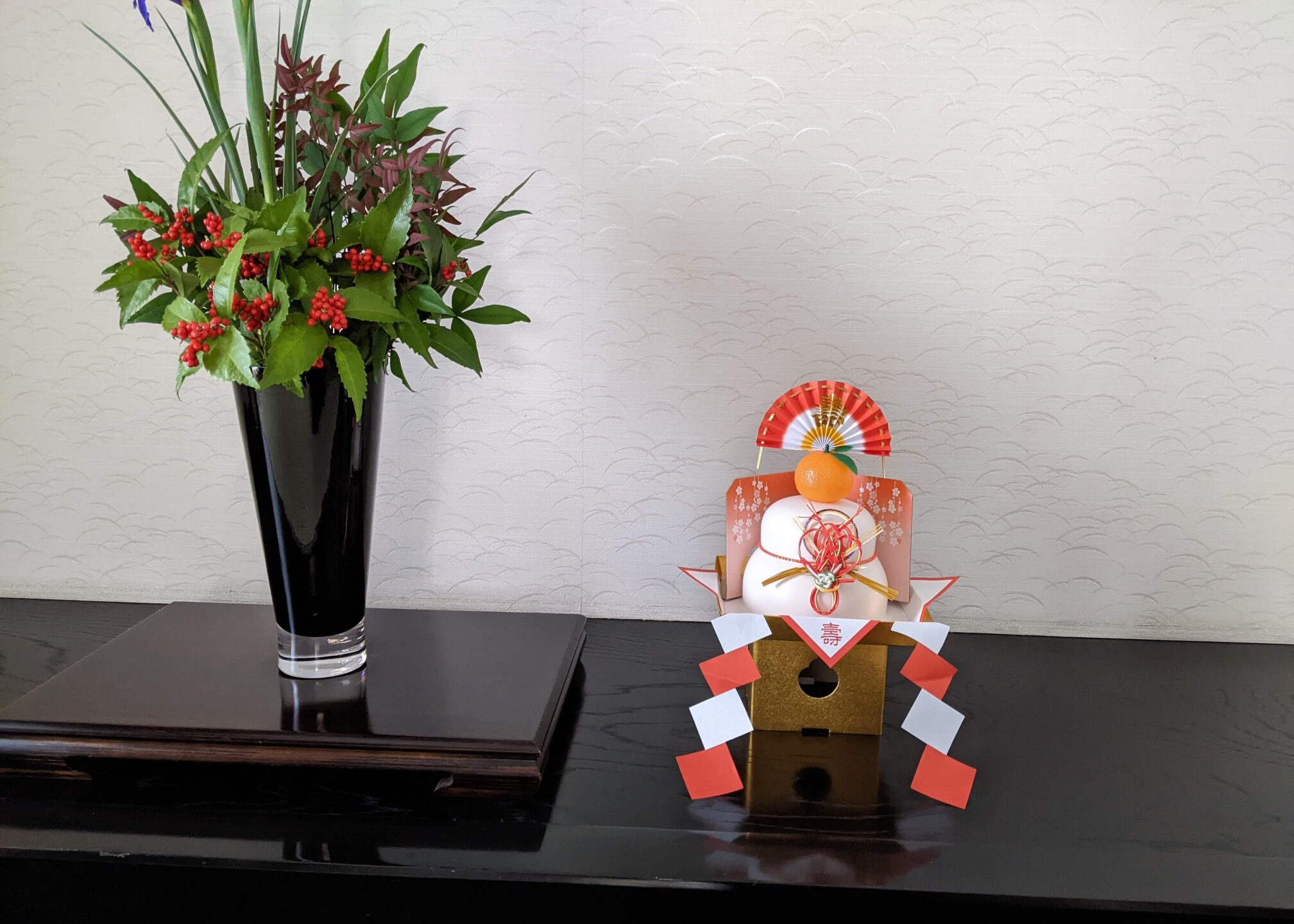
写真:鏡餅、The rigft side is Kagami-mochi, decorated in Tokonoma(=Japanese selemony room).
飾った鏡味もちは、固くなっています。
The decorated Kagami-mochi is hard,
1月11日に鏡餅は割られ、ぜんざいとして食べられます。
On January eleventh Kagami-mochi is divided, mixed with Zenzai and eaten.
ぜんざい(Zenzai=sweet adzuki soup)
・・・ぜんざいは、餅のかけらと甘いアズキの汁と粒が一緒になった汁です。
Zenzai is a sweet adzuki(red-been) soup with pieces of rice cake.
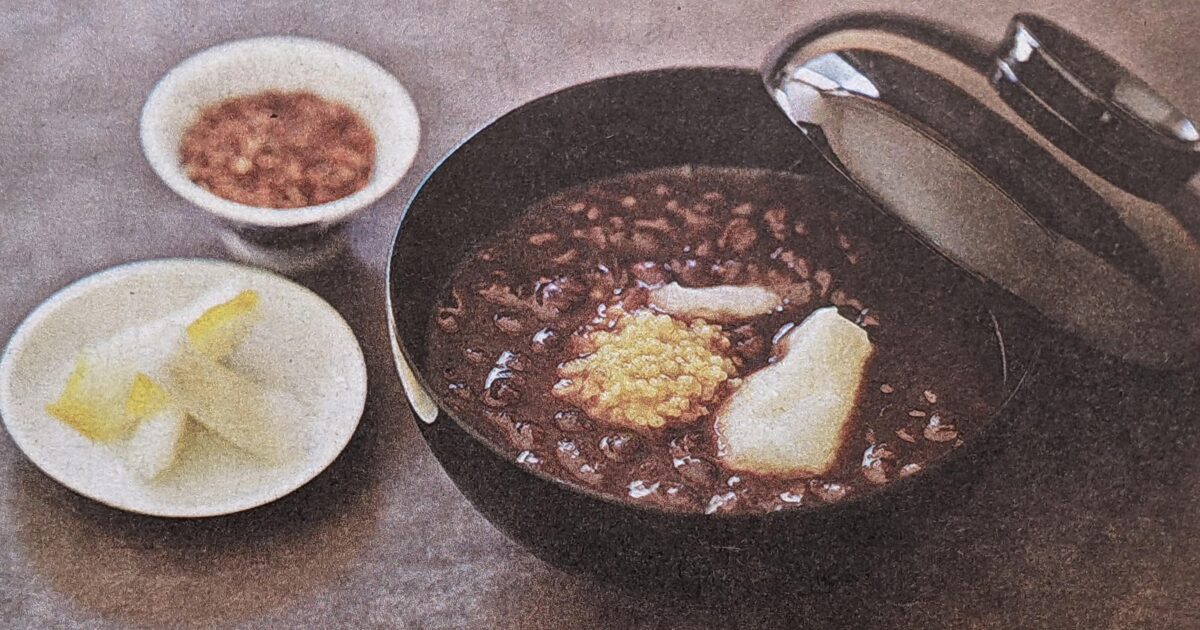
写真:Zenzai=there are many pieces of adzuki(red-been)。
小豆粥(Azukigayu)
1月15日(小正月=First Full Moon Festival)に小豆の入ったお粥を食べる習慣があります。
We have a custom to eat rice porridge with red beans on January 15th.
一年の邪気を払うための習慣です。
It is a custom to get rid of evil spirits throughtout the year.
家庭料理(home cooking)
主食はご飯(staple food is boiled rice)
・・・お米のおいしさは、ツヤ、見た目、甘み、香りで判断します。
When assessing the quality of a boul of rice, look for sheen the appearance of grains, sweetness of taste, and fragrance.
家庭料理の主食は、ご飯(炊いた米)です。
The staple food of Japanese is boiled rice.
ほかに粥やお茶漬けもあります。
There are also rice porridge and Ochazuke.
飲みすぎた後や病気で食欲のないときに最適です。
They are just right after drinking or when you have a poor appetite because of illness.
お茶漬けはご飯の上からお茶を注いだものです。
Ochazuke is boiled rice with tea poured over it.
日本の家庭料理にはたくさんの種類のお茶漬けがあります。
There are many kind of Ochazuke in Japanes home cooking.
写真:マグロちゃずけ(tuna-ochazuke)
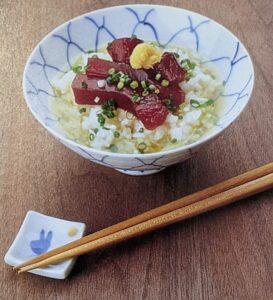 写真:「お茶漬け一杯の奥義」より。
写真:「お茶漬け一杯の奥義」より。副菜/添え料理(side dishes)
・・・家庭料理の副菜は、ほとんどの場合海産物と野菜が多いです。
Side dishes are mostly seafood and vegetables.
我々はたくさんのいろんな種類の魚や海産物を食べます。
In my house, we eat a lot of different types of fish and sea food.
みそ汁(miso soup)
味噌(miso)
味噌は、まめを発酵させた食品です。
Miso is a fermented soybean paste.
主な原料は大豆ですが、米や大麦を使うこともあります。
The main ingredient is soy beans, but sometimes rice or barley are used.
みそ汁(miso soup)
家庭料理に欠かせないみそ汁は、だしとみそを混合したものです。
Miso soup is a mixture of soup stock and miso.
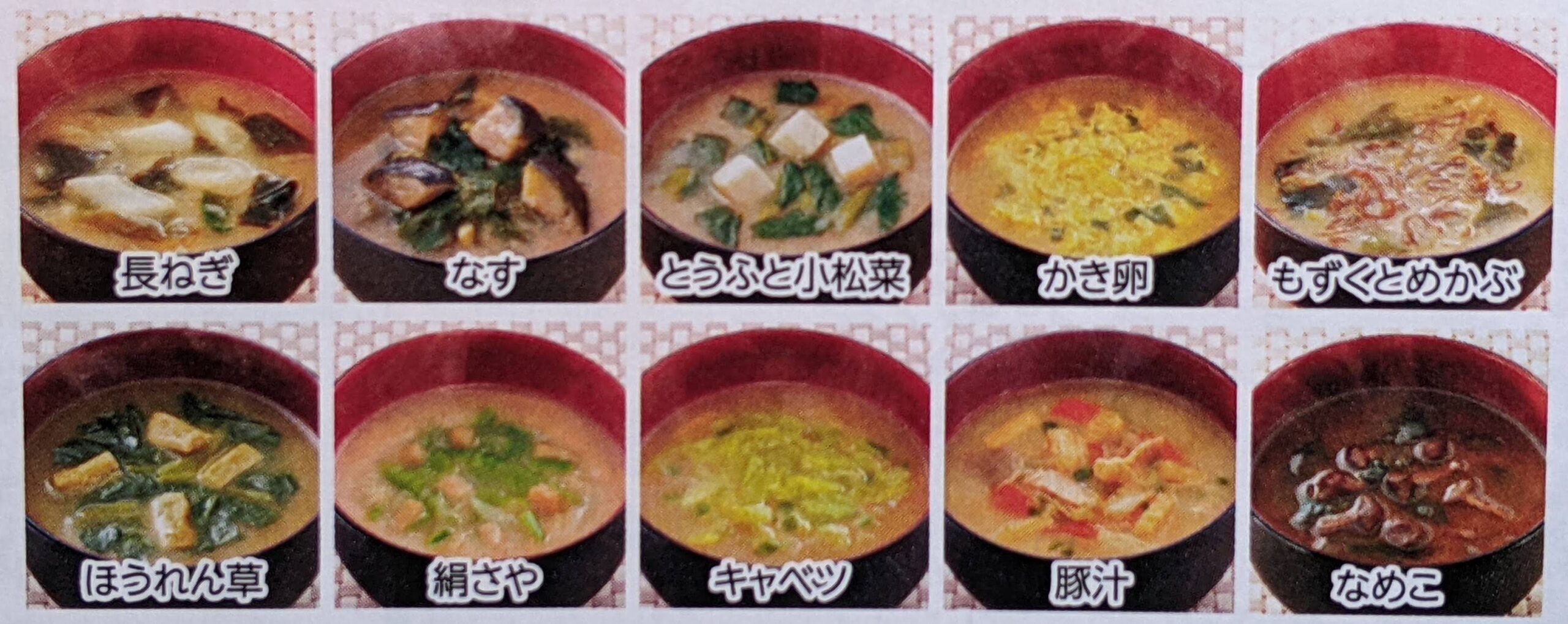 写真:miso-soupe(with long-green-onion/eggplant/tofu/beaten-egg and others)
写真:miso-soupe(with long-green-onion/eggplant/tofu/beaten-egg and others)
だし(dashi=soup stock)
だしを使った家庭料理は日本料理の特徴の一つです。
The dish with dashi is one of the characteristics of Japanese cuisine.
だしをとる食材
だしをとるには、たくさんの食材を使います。
Dashi is made by making a lot of ingredients.
例えば、かつお節・昆布・煮干し・干しシイタケなど。
For example; dried bonito shavings, dried tangle, dried small sardines, dried shiitake mushroom and others.
みそ汁に入れる食材
みそ汁にはいろんな食材を入れます。
We put various ingredients in Miso soup.
例えば、長ネギ・ナス・豆腐・油揚げ・小松菜・かき卵・わかめ・ほうれん草・きゃべつ・なめこなど。
For example; long onion ,egg plant, tofu, deep fried tofu, leafy green vegetable, beaten egg, sea weed ,spinach, cabbage, nameko mushrooms and others。
家庭料理の傾向(Japanese food tends)
・・・家庭料理の中で肉じゃがは、日本を代表する肉を使った煮込み料理です。
Nikujaga(= Meet and potato stew) is a typical home cooking that uses meet.
ジャガイモ・牛乳・玉ねぎなど甘辛いだしで煮込みます。
Potetoes,beef,and onions are simmered in salt-sweet soup.
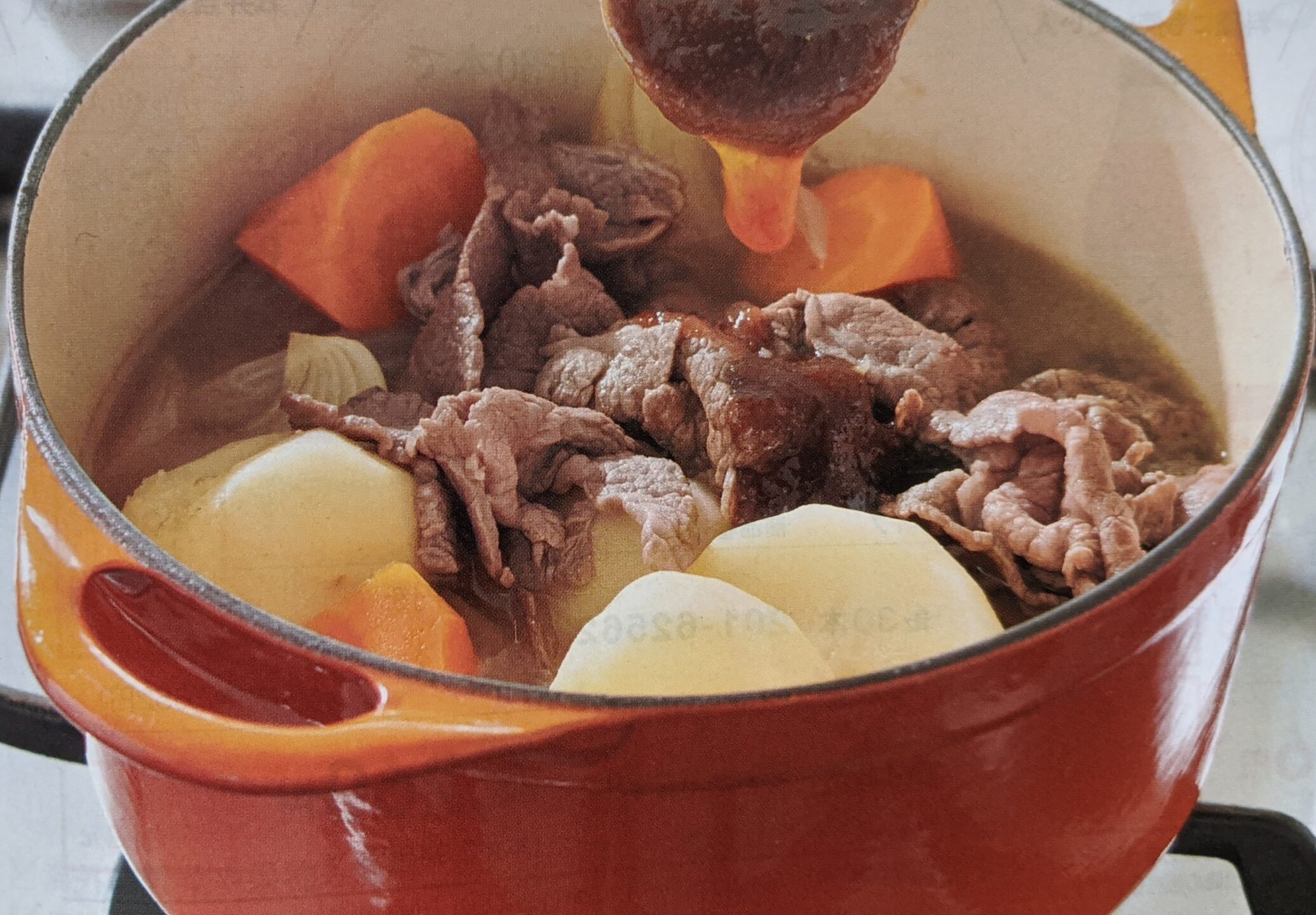
写真:肉じゃが(nikujyaga= meat & potato)
肉を多く食べない。
私たちは、さかなと海産物を食べるが肉は多く食べない。
We eat fish and seafood but we don’t eat much meat.
家庭料理では、代表的な肉料理の肉じゃがでもこの程度です。(写真を参照ください)。
Even a typical meat dish(meat & potato) is like this at our home. (Please refer to the picture.)
スパイスやハーブは多く使わない。
私たちの家庭料理は、スパイスやハーブは多く使わない。
We don’t use many spices or herbs in our cooking.
ポテトはそう多く食べない
たくさんの米やいろんな種類のパスタほど、ジャガイモはたくさん食べない。
We eat a lot of rice and some types of pasta, but not very many potatoes.
漬物(tsukemono=pickles)
野菜の漬物(pickled vegetables)
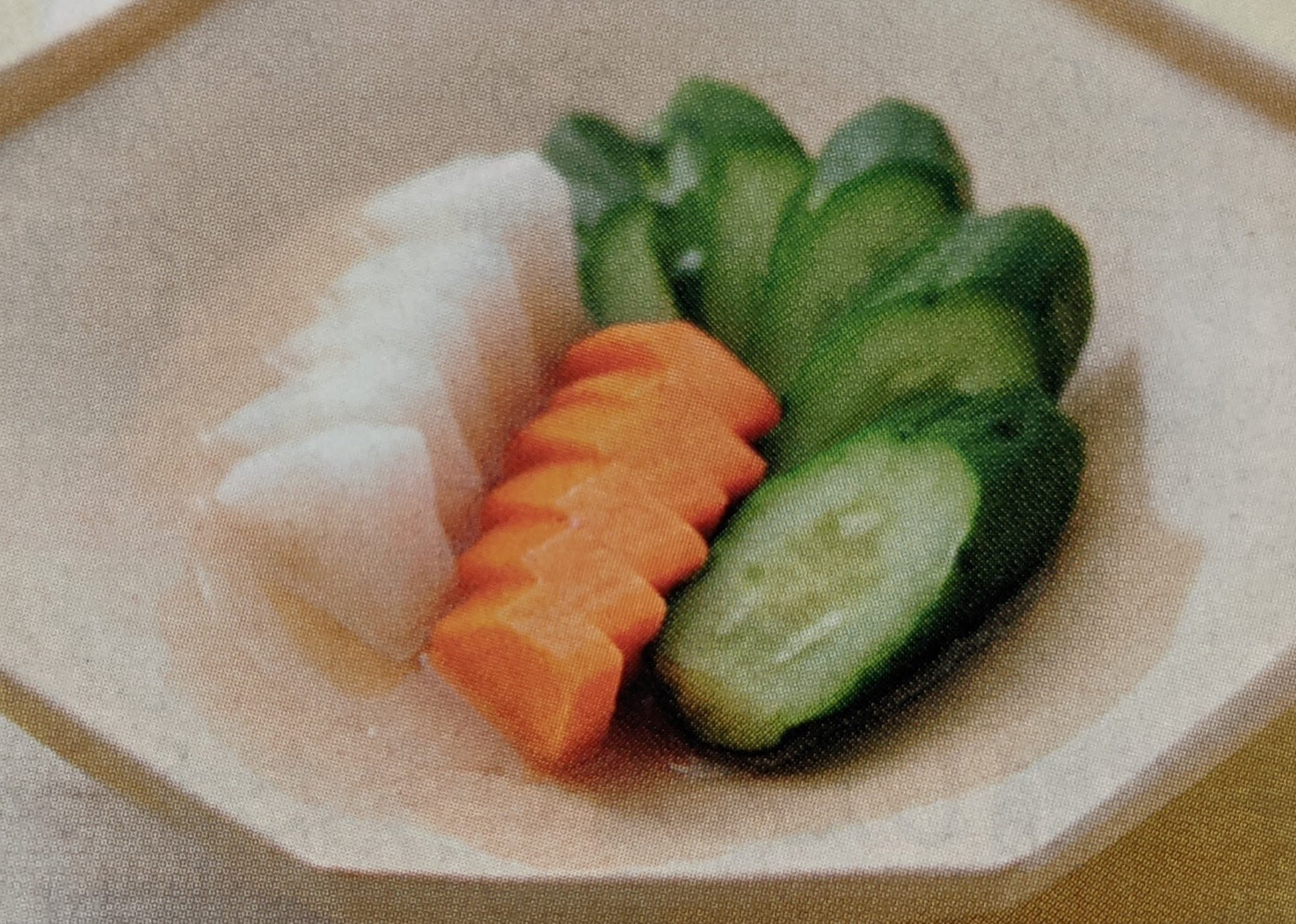 写真:きゅうり・大根・人参の漬物。
写真:きゅうり・大根・人参の漬物。
主な漬物野菜(main types of vegetables)
例えば、白菜・きゅうり・ナス・大根・人参など。
For example; Chinese cabbage, cucumber, eggplant, radish, carrot and others.
飲み物(beverage)
お茶(tea)
・・・一般的に日本茶は、「お茶」と呼ばれています。お茶と水はレストランではだいたい無料です。
Japanese tea is called Ocha in Japajese. Ocha and water are usually serned for free in restaurants.
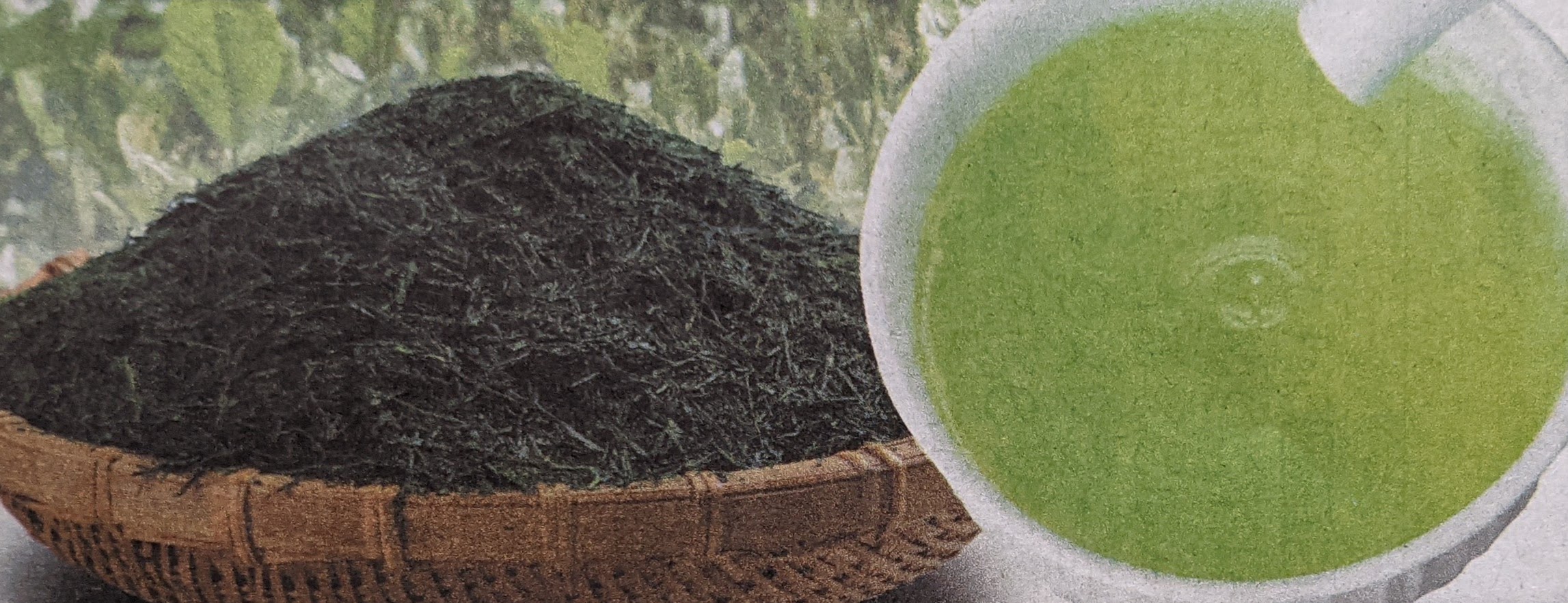 写真:Ocha(=green tea)
写真:Ocha(=green tea)お茶には普通の飲み物としてのお茶(Green tea)と抹茶(Matcha)そしてほうじ茶(Houji-cha)などがあります。
There are green tea, powered green tea and roasted green tea and others.
お茶(green tea)は、日本で最も普及している飲み物です。
Green tea is the most popular drink in my country.
抹茶(powered green tea) は伝統的茶道の飲み物として飲まれます。
Matcha is drunk as a traditional tea ceremony.
ほうじ茶(roasted green tea)
Houji-cha is roasted (low-grade) green tea
麦茶(Mugi-cha=Barley tea)
It is a tea made by boilling roasted barley.
尚、日本茶の詳細は、日本茶(緑茶)、歴史・製法・種類。(麦茶)、歴史・製法・種類と楽しみ方・効能。(昆布茶)その他。を参照ください。
コーヒー(coffee)
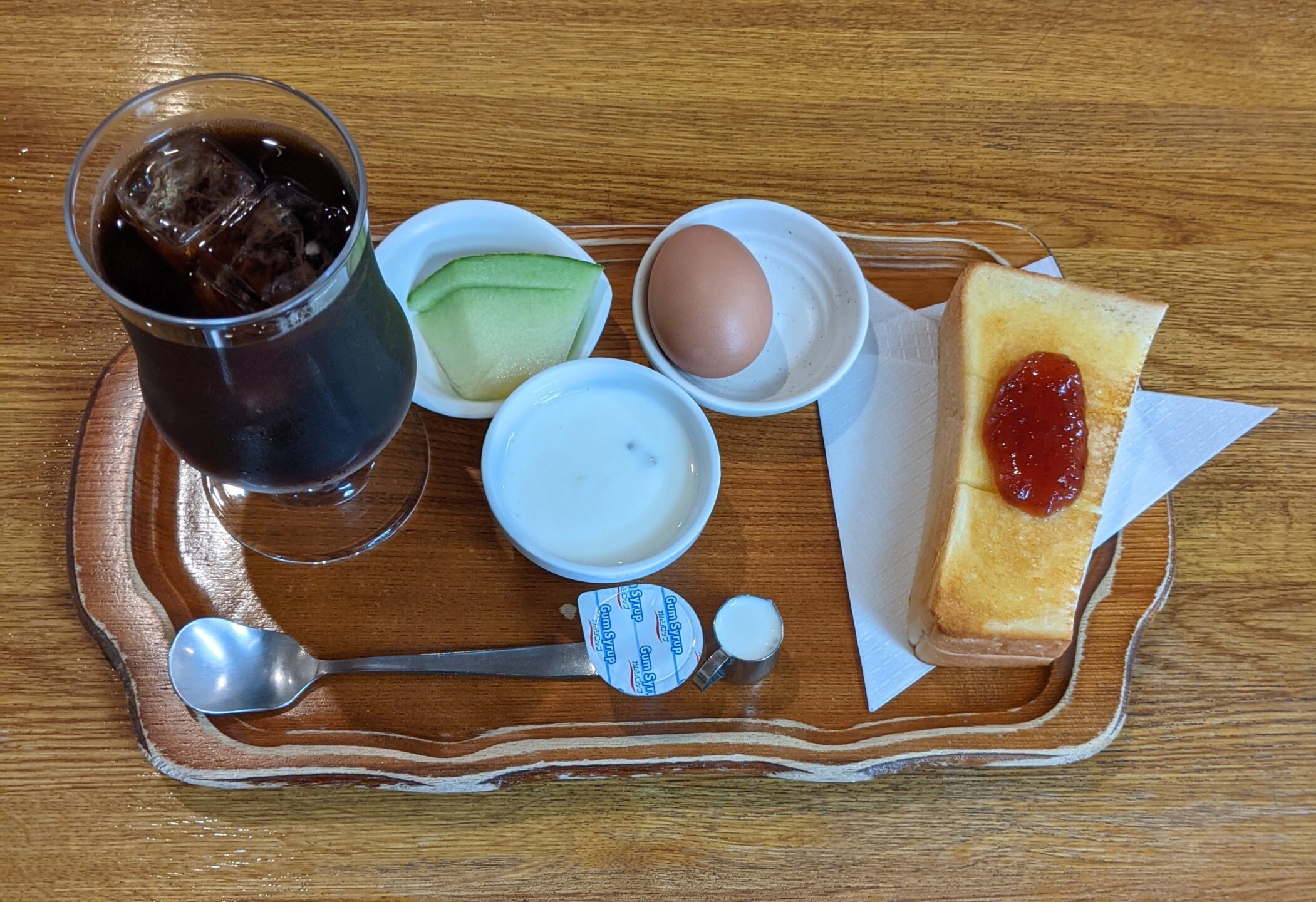 写真:モーニングサービス(morning service)、日本で最初の「喫茶四季」のモーニングサービス。詳細:ブログ記事、二人展「画廊喫茶四季」をご参照ください。
写真:モーニングサービス(morning service)、日本で最初の「喫茶四季」のモーニングサービス。詳細:ブログ記事、二人展「画廊喫茶四季」をご参照ください。
わが国では、比較的年配者はたくさんのコーヒーは飲みません、しかし若者の間では飲み物として人気が高まってきています。
Older people don’t drink much coffee in my country, but it is becoming popular with young people.
酒(Sake、alcohol)
日本酒(Sake= Japanese liquor)
・・・私たちは、米から作ったいくらかのアルコールを飲みます。それは、酒と呼ばれています。
We also drink some alcohol which is made from rice, it’s called Sake.
甘酒(Amazake=sweet sake)
甘酒は酒粕(=飯と米麹を混ぜ醸す)から作ります。
A sweet alcoholic drink made from fermented rice.
古くは夏の飲み物でした。
It use to be a summer drink.
焼酎(Shochu=distilled liquor)
・・・芋から作った酒(焼酎)も人気があります。それは、蒸留酒です。
Shochu made from sweet potatoes also popular, it’s a clear distilled liquor.
ビール(Beer)
・・・夏はとても暑いので、飲み物としてたくさんのビールを飲みます。
In the summer , it is hot so we drink a lot of beer.
朝食(breakfast)
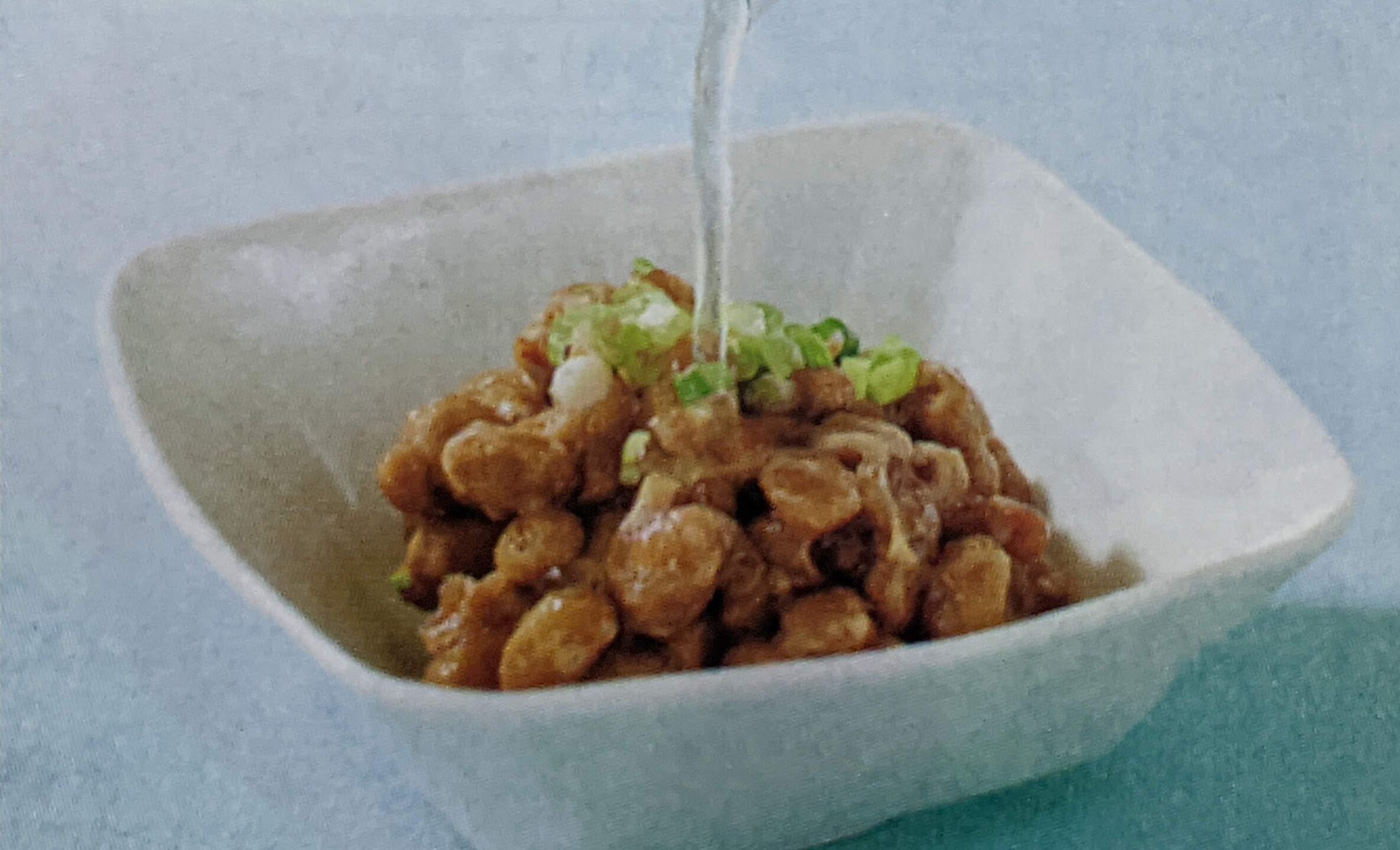 写真:なっとう(nattou= fermented soybeans)
写真:なっとう(nattou= fermented soybeans)典型的な朝食(typical breakfast)
・・・典型的な朝食は、ごはん・味噌汁・生卵・納豆・魚です。
A typical breakfast is rice, miso soup, egg, nattou (fermented soybeans) and fish.
例えば(朝食の魚);ほし魚・焼き魚・煮魚など。
For example (fish) ; dried fish, grilled fish and fish boiled in broth and others.
簡単な朝食(light breakfast)
朝食と言えば、少数の若い人の中にはトーストかシリアルにコーヒーか野菜ジュースの人もいます。
Speaking of breakfast, some young people have toast or cereal and coffee or vegetable juice.
幾人かの人々は、健康のため朝食を控える人もいます。
Some people refrain from eating breakfast for there health.
朝食を食べないことは、かえって健康に悪いと思います。
I think not eating is actually bad for their health.
サンドイッチ(sandwich)
・・・サンドイッチは、今では昼食・朝食として多くの人に一般的です。我々はしばしば卵にいくらかのパンとスープも食します。
Sandwiches are now more common for lunch and for bleak fast, we often have an egg and some bread or even some soup.
昼食(lunch)
サラリーマン(office worker’s lunch)の昼食はどうでしょうか?
弁当(Bento=box lunch)
近くに食堂のない人々の昼食には便利です。
It’s convenient for people who don’t have a cafeteria nearby.
健康上の理由で昼食は家庭で作った弁当を食べる人もいます。
Some people eat lunch made at home for health reasons.
昼食のお弁当のおかずは何がいいですか。
What would you like for your box lunch?
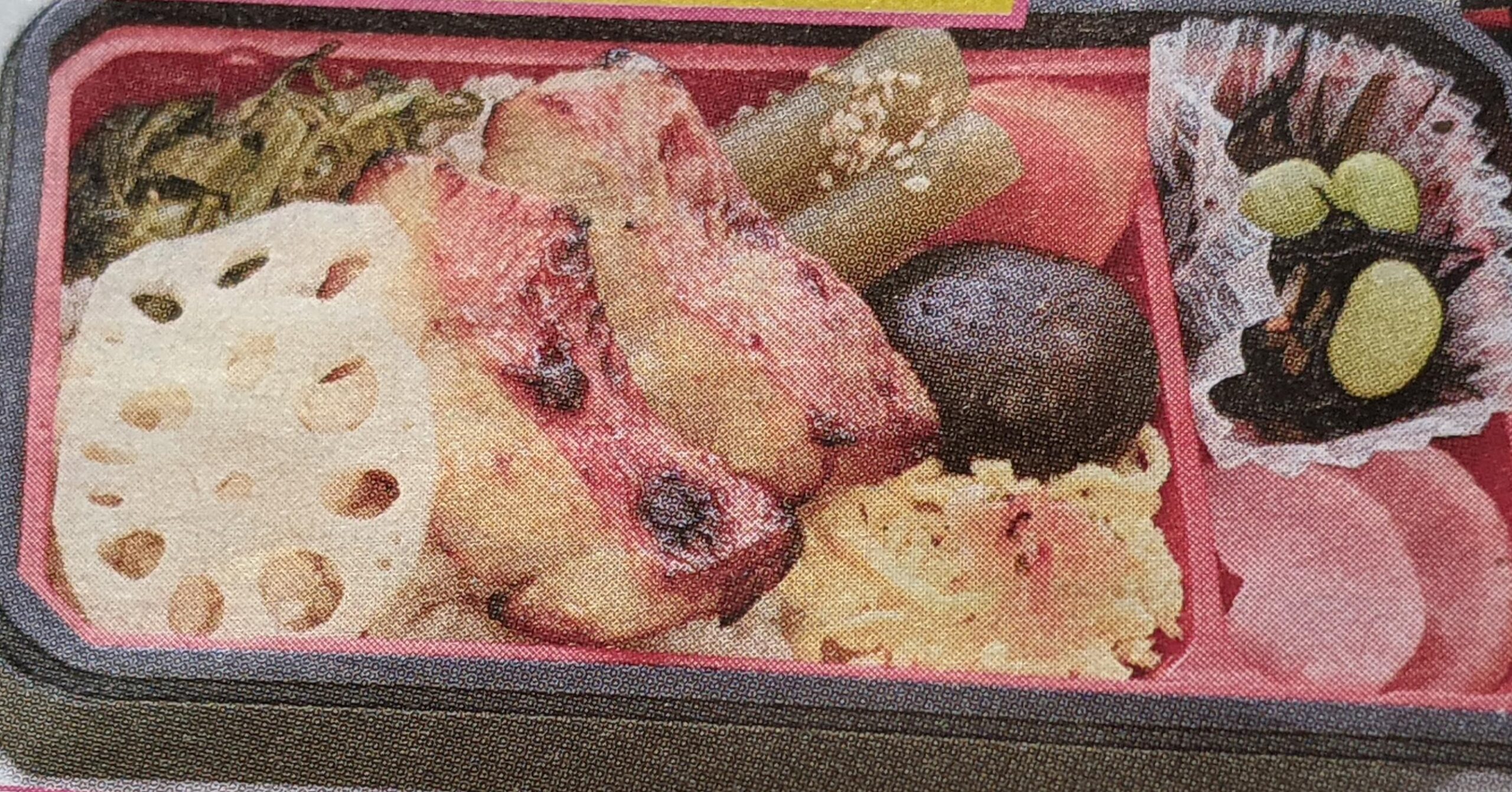
たくさんの種類の弁当が売っています。
Many kinds of lunch boxes are sold.
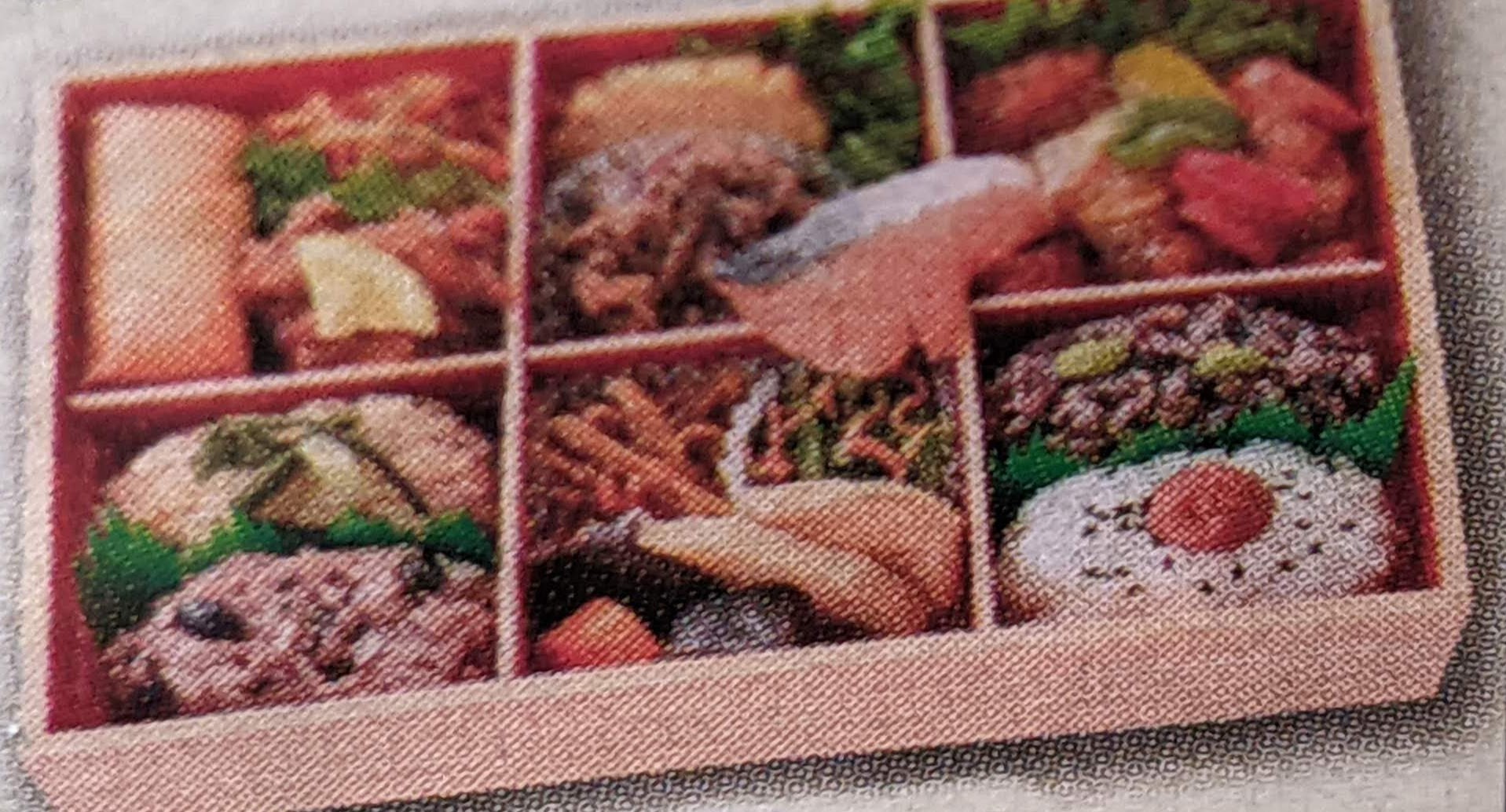
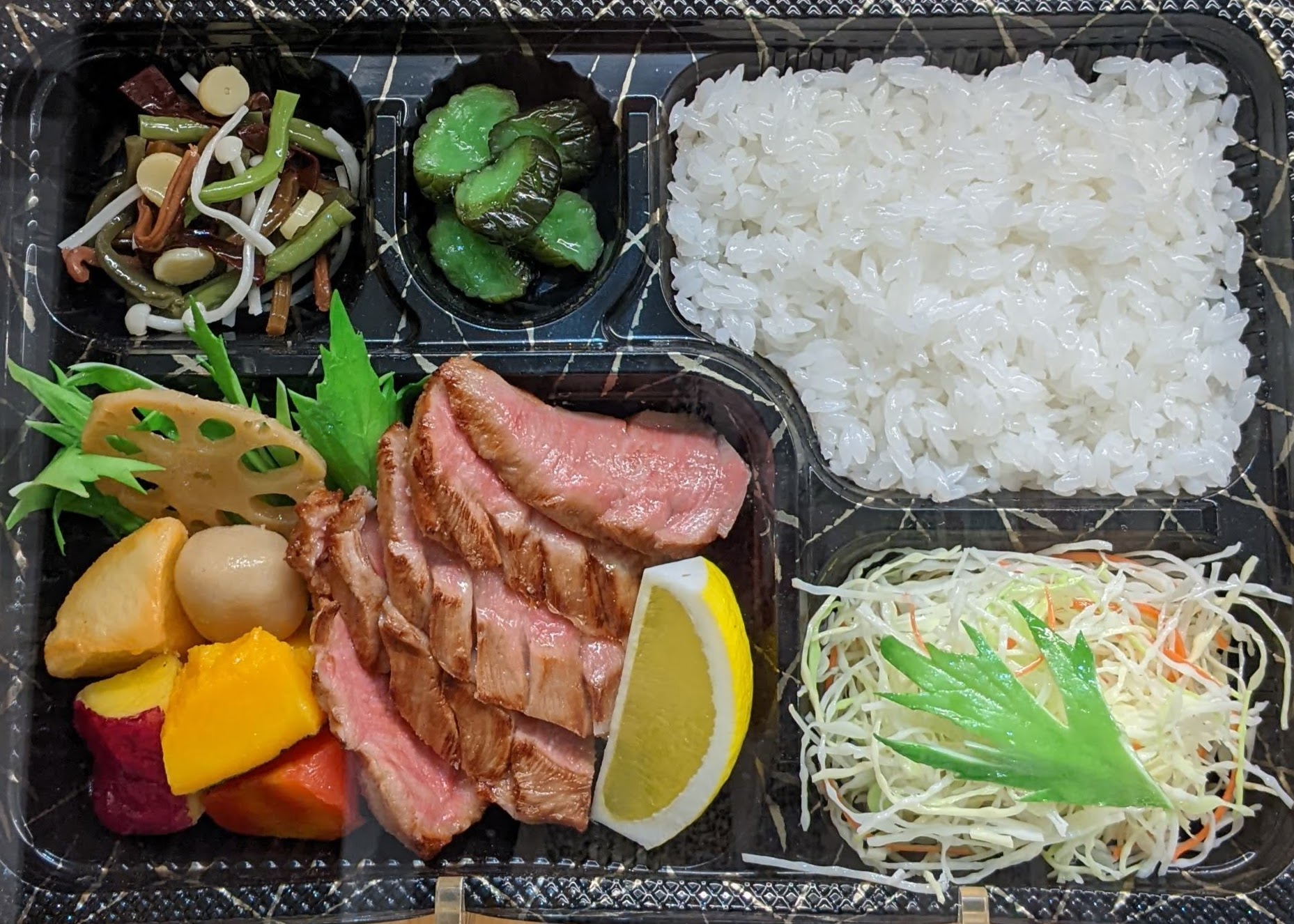 写真:肉弁当(meet bento)、refer to the picture.
写真:肉弁当(meet bento)、refer to the picture.
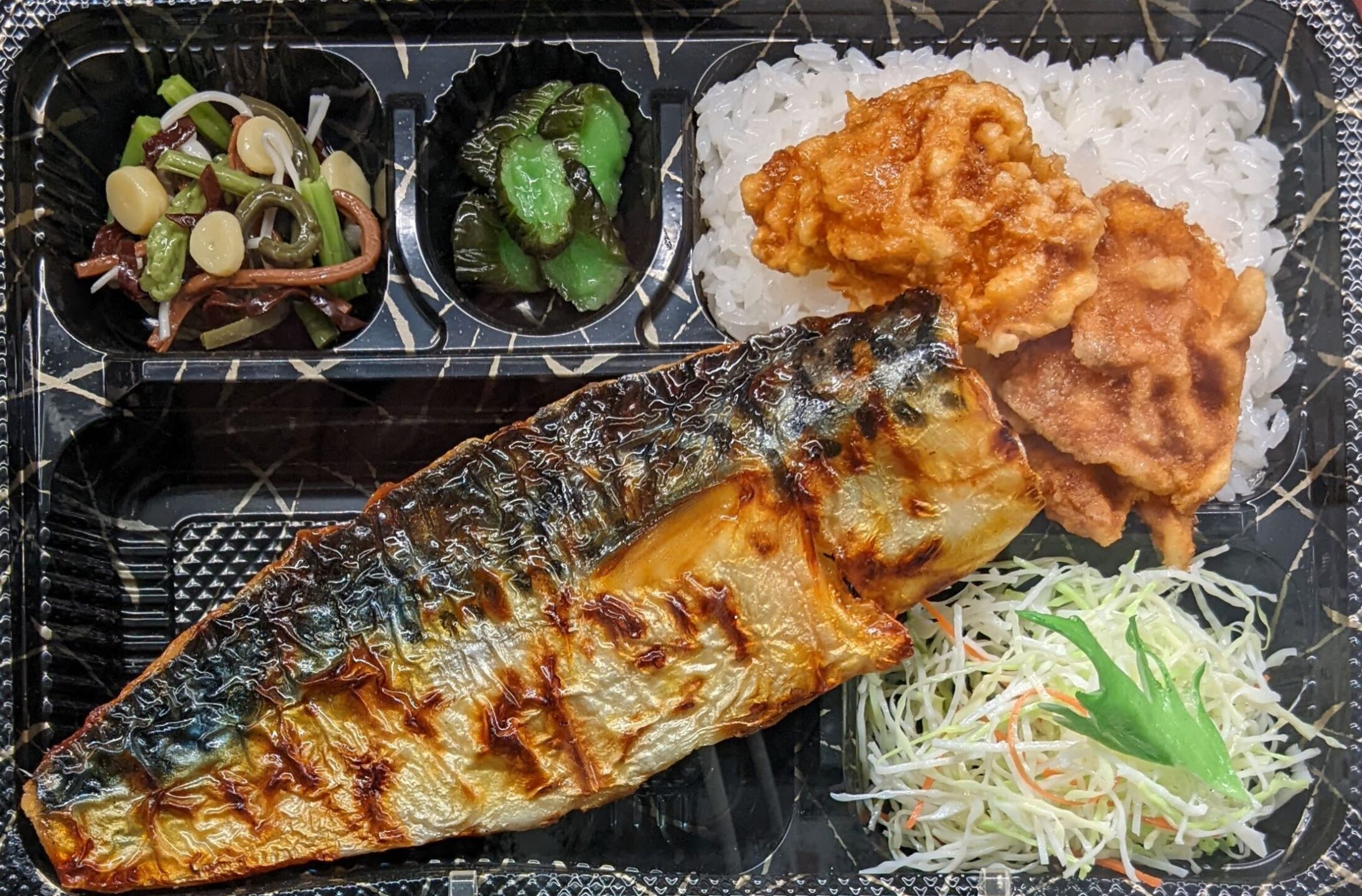 写真:さかな弁当(fish bento)、refer to the picture.
写真:さかな弁当(fish bento)、refer to the picture.
おにぎり(Onigiri=rice ball)
おにぎりは毎朝、店頭に届けられます。
Onigiri is delivered to the store every morning.
いつも新鮮で種類も充実しています。
They are always fresh and there are many kinds.
例えば、鮭・梅・昆布・たらこ・五目・赤飯・鰹節・ツナマヨネーズなど。
For example; salmon, plum, sea tangle, cod roe , mixed rice, rice with red beans, dried bonito shavings, tuna & mayonnaise and others.
コンビニのサンドイッチ
・・・大手コンビニと言えば、セブンイレブン/ファミリーマート/ローソンなどです。
Speaking of major convenience store are Seven eleven, Family Mart, Lawson and others.
大手コンビニの食品は、種類豊富で味もよいサンドイッチを提供しています。
They sell rich in variety of sandwiches with good taste.
サンドイッチに関しては、良い味の新商品の開発に向け追及しています。
As for sandwiches, they pursue development of new good taste.
最近はフルーツのサンドイッチの評判が良いようです。
It seems that fruit sandwiches have a good reputation recently.
果物サンド(fruit sandwich)
例えば、イチゴ・キウイ・ミカン・甘夏・ミックスフルーツ。
For example; strawberry, kiwi fruit, mandarin orange, sweet summer orange, mixed fruit.
従来からの商品も好評です。
Conventional sandwich also have a good reputation.
例えば、ハムサンド・卵サンド・カツサンド・小倉サンド。
For example; ham, egg, fried pork cutlet, azuki bean.
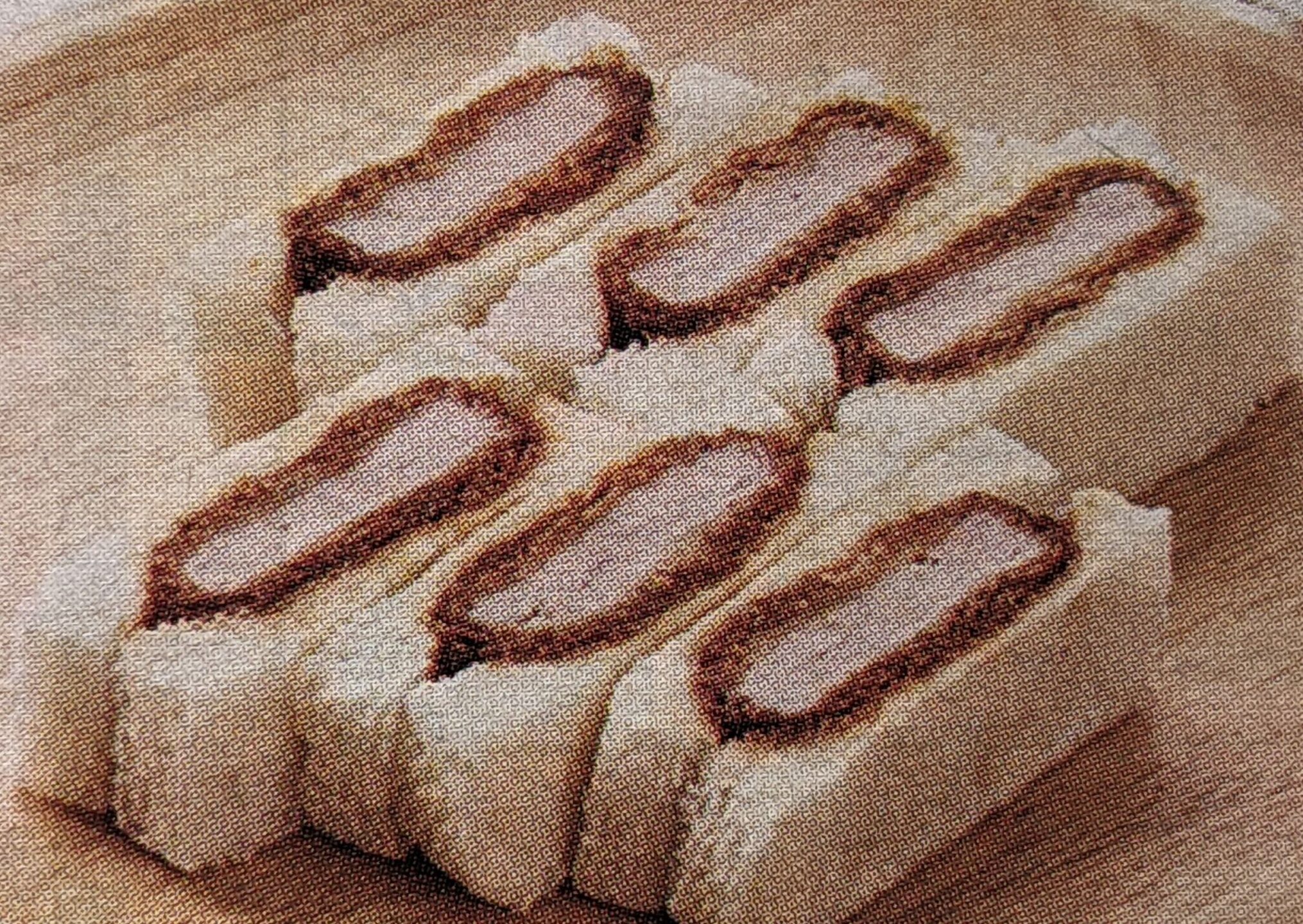 写真:カツサンド(katsu-sando=fried pork cutlet)、refer to the picture.
写真:カツサンド(katsu-sando=fried pork cutlet)、refer to the picture.
弁当やおにぎり、他の様々な食べ物のランチをコンビニで済ませる人も少なくありません。
Quite a lot of Japanese buy there lunch such as bento, rice balls, and other prepared foods at convinience stores,
コンビニは、日本のデリカテッセンともいえます。
In some ways, it is the Japanese version of a delicatessen.
外食(eat out)
・・・サラリーマン相手に市街地ではたくさんの食堂がいろんなメニュウーをそろえています。
There are many restaurants in the urban area for office workers.
外食で人気、日本料理定食(lunch set、①・②・③)
・・・日本料理の基本は、一汁(one soup)三菜(three side dishes)です。
Japanese food is basically Ichijyu(one soup)-sansai(three side dishes).
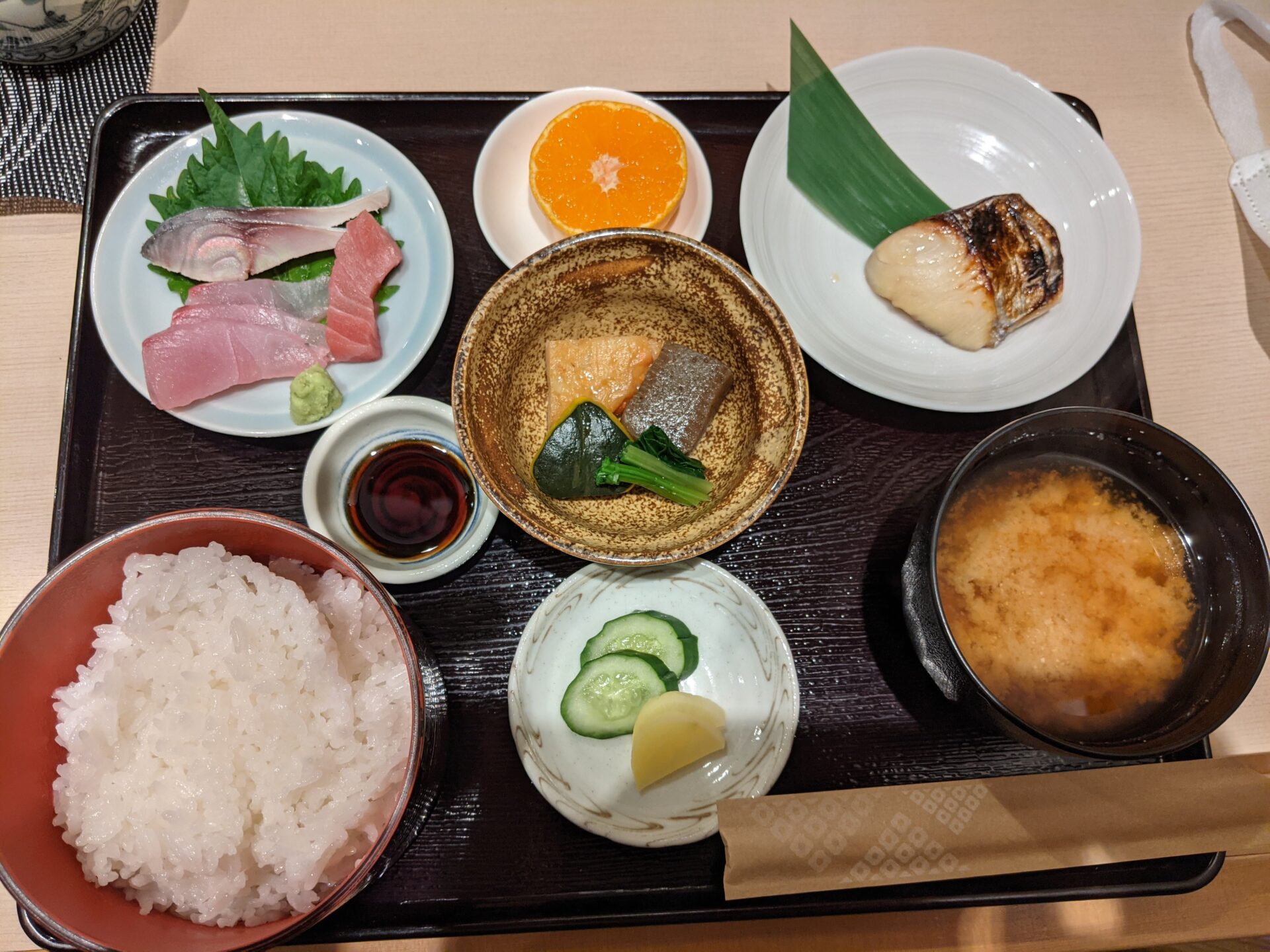
写真①:焼き魚+さしみ定食(Grill fish & sashimi set menu) 、One soup(=miso soup) and Three dishes(sashimi/ grilled fish/vegetables).Others(Pickles/Small dessert)。
例えば、さしみ・とんかつ・生姜焼き・天ぷら・おにぎりなど。
For example ; sashimi=fresh slices of raw fish, ginger-flavored slices of fried pork , tempura , onigiri and others.
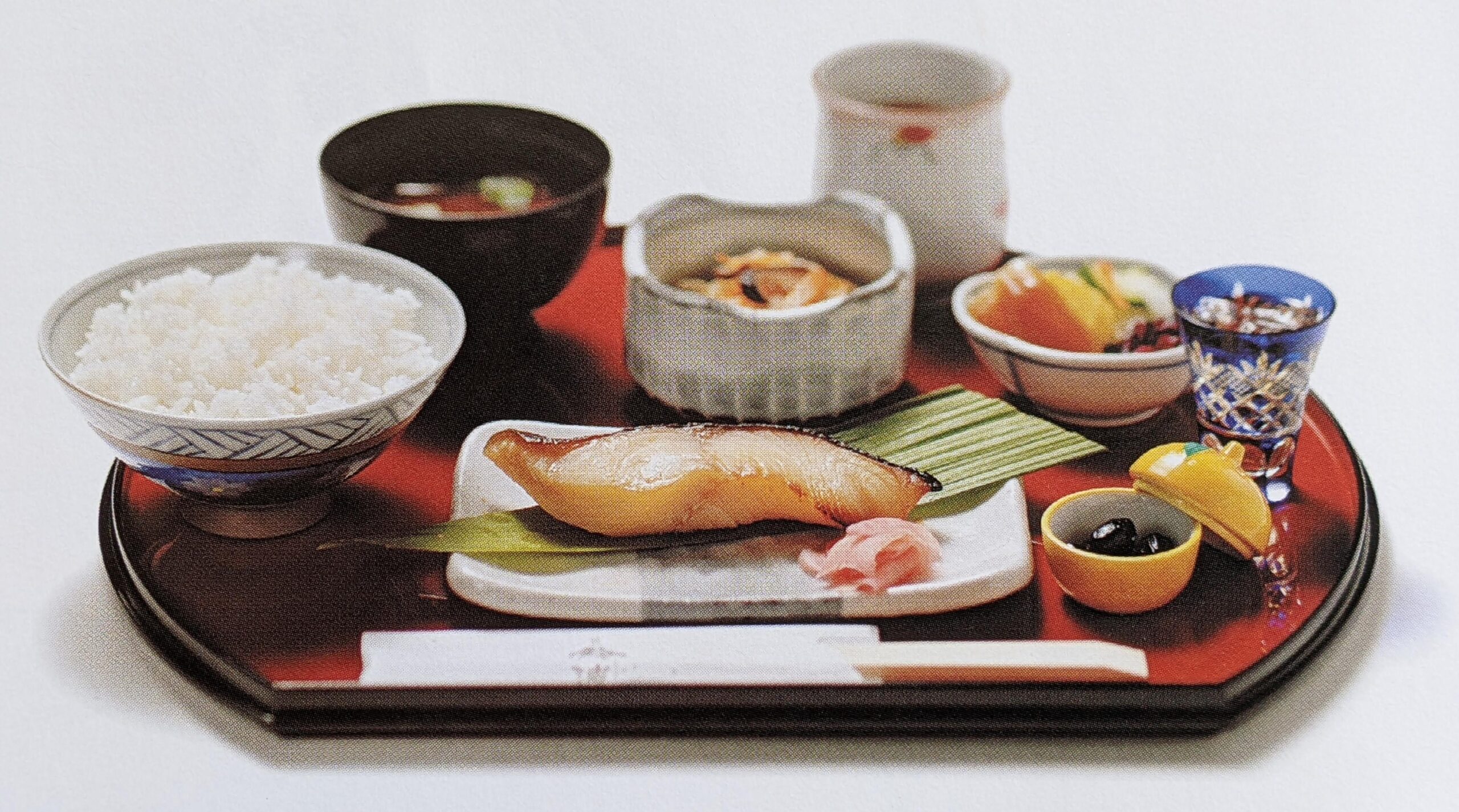 写真②:鈴波のランチセット。
写真②:鈴波のランチセット。
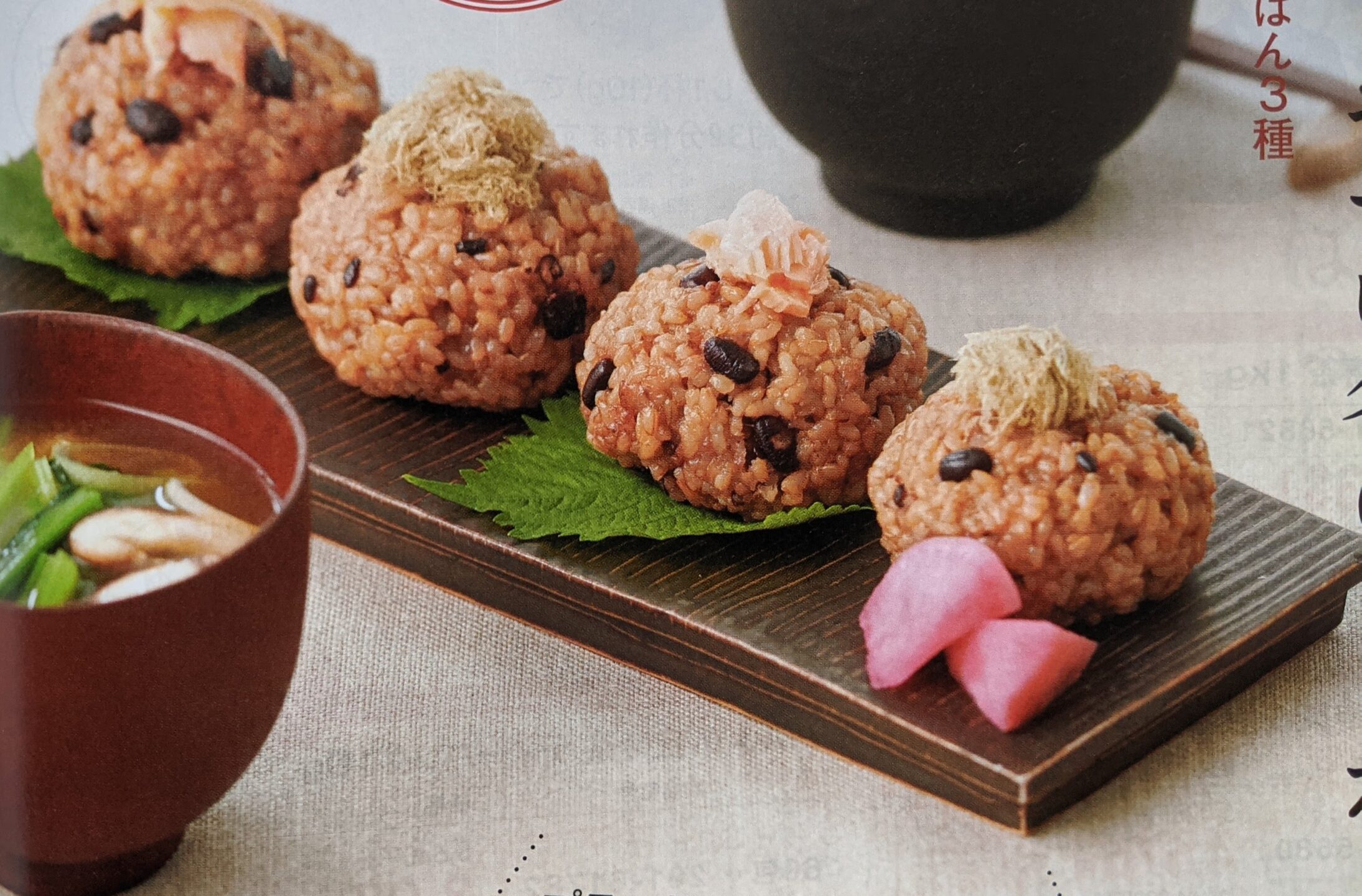
写真③:おにぎりセット(rice ball mixed red beans set)、refer to the picture.
外食単品ランチ(Ala carte lunch)
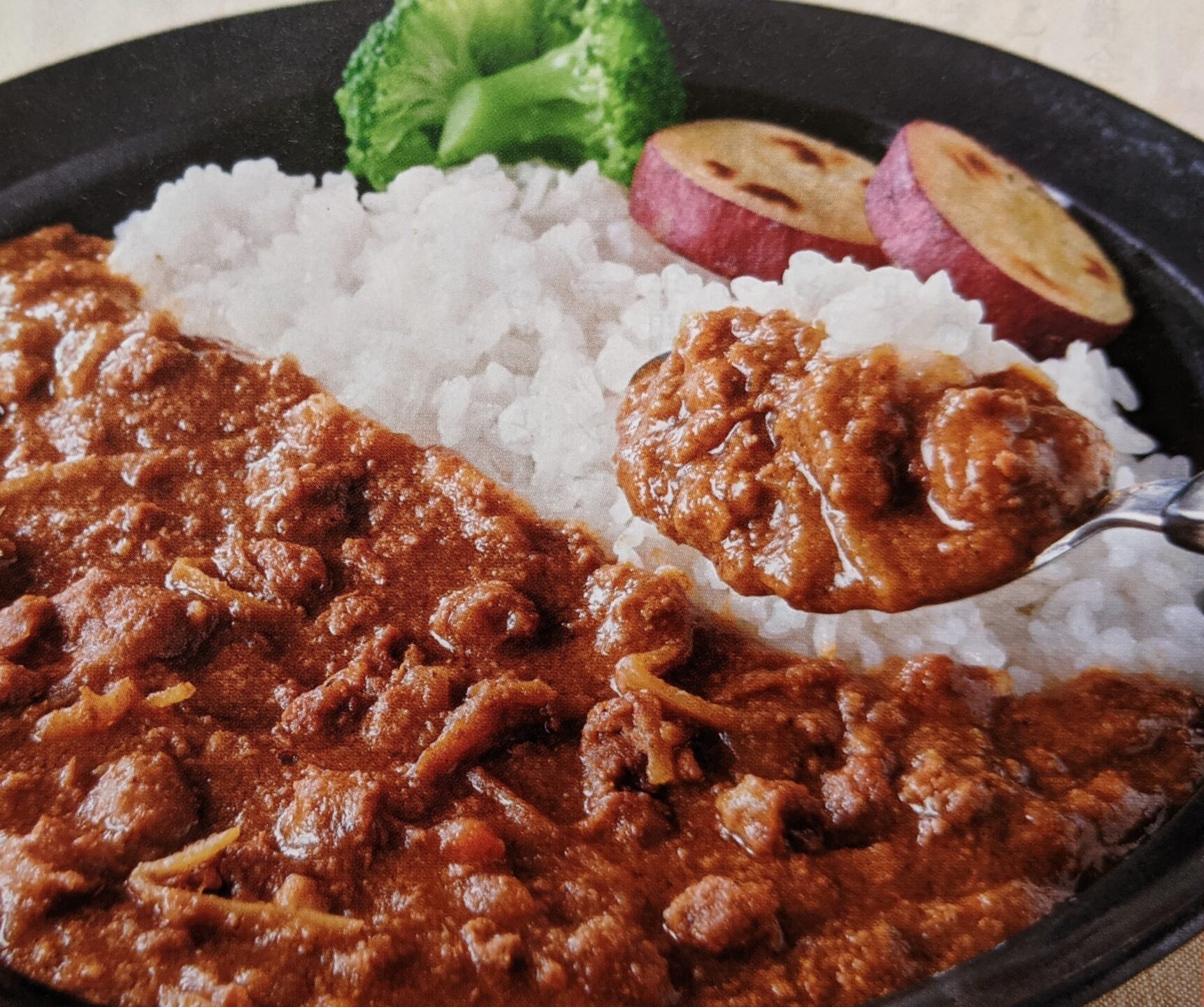 写真:カレーライス、refer to the picture.
写真:カレーライス、refer to the picture.
例えば、カレー・スパゲティー・うな重・海鮮どんぶり・マグロどんぶり・親子どんぶり・イクラどんぶり等。
For example; curry, spaghetti, broiled eel, sea food bowl, raw tuna bowl, chicken and egg bowl, salmon roe and others.
寿司(sushi)
寿司;酢飯に生魚やいろんな食材をのりに巻いたもの。
sushi; vinegared rice topped with raw fish, or rolled in seaweed with various ingredients.
寿司ランチ
寿司は、ボリュームも値段も豊富にそろえてあり、短時間で手軽に食べれて、根強い人気があります。
Sushi is abundant in variety, price and quality. It is very popular because you can eat it easily in a short time.
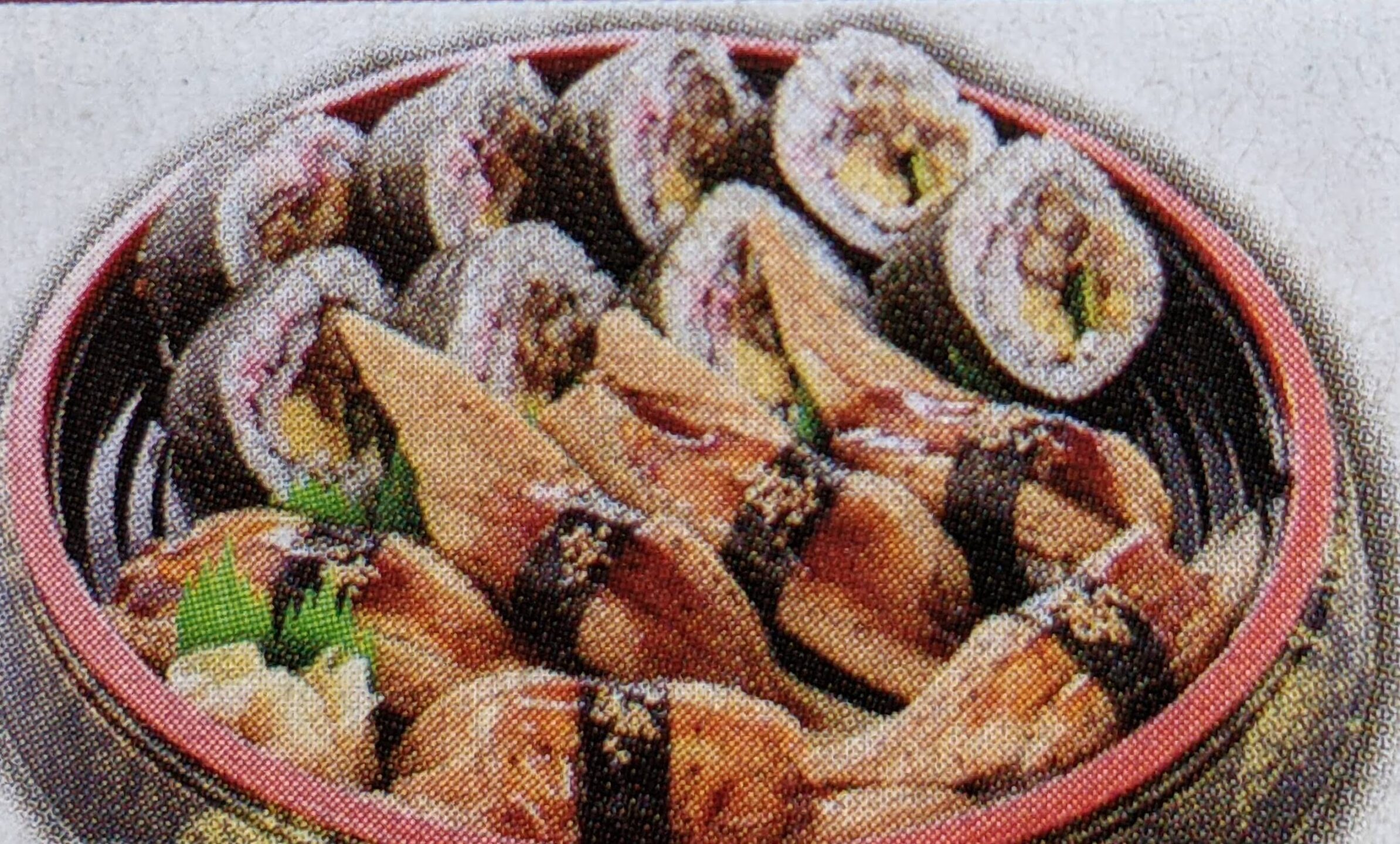 写真:寿司セット(sushi set)、refer to the picture.
写真:寿司セット(sushi set)、refer to the picture.
例えば、寿司セット・巻きずし・稲荷ずし・ちらし寿司。
For example; Sushi set, Sushi roll, pouch of fried bean stuffed sushi rice, mixed ingredients and sushi rice.
寿司屋(Sushi bar)
伝統的な寿司屋は、カウンター式です。
A traditional sushi restaurant is counter style.
大衆向けから高級店までさまざまな寿司屋さんが存在します。
There are various from casual shops to high-class shops.
回転寿司(Kaiten-zushi=revolving sushi bar)
お客は、循環するベルトで運ばれてくる寿司を選びます。
Customers choose the sushi from a revolving conveyor belt.
お値打ちな値段で、特にファミリー層に人気があります。
It’s reasonable price, especially popular among families.
宅配寿司(Takuhai sushi=home delivery sushi)
近年は、宅配すしも人気があります。
Home-delivery sushi is also popular in recent years.
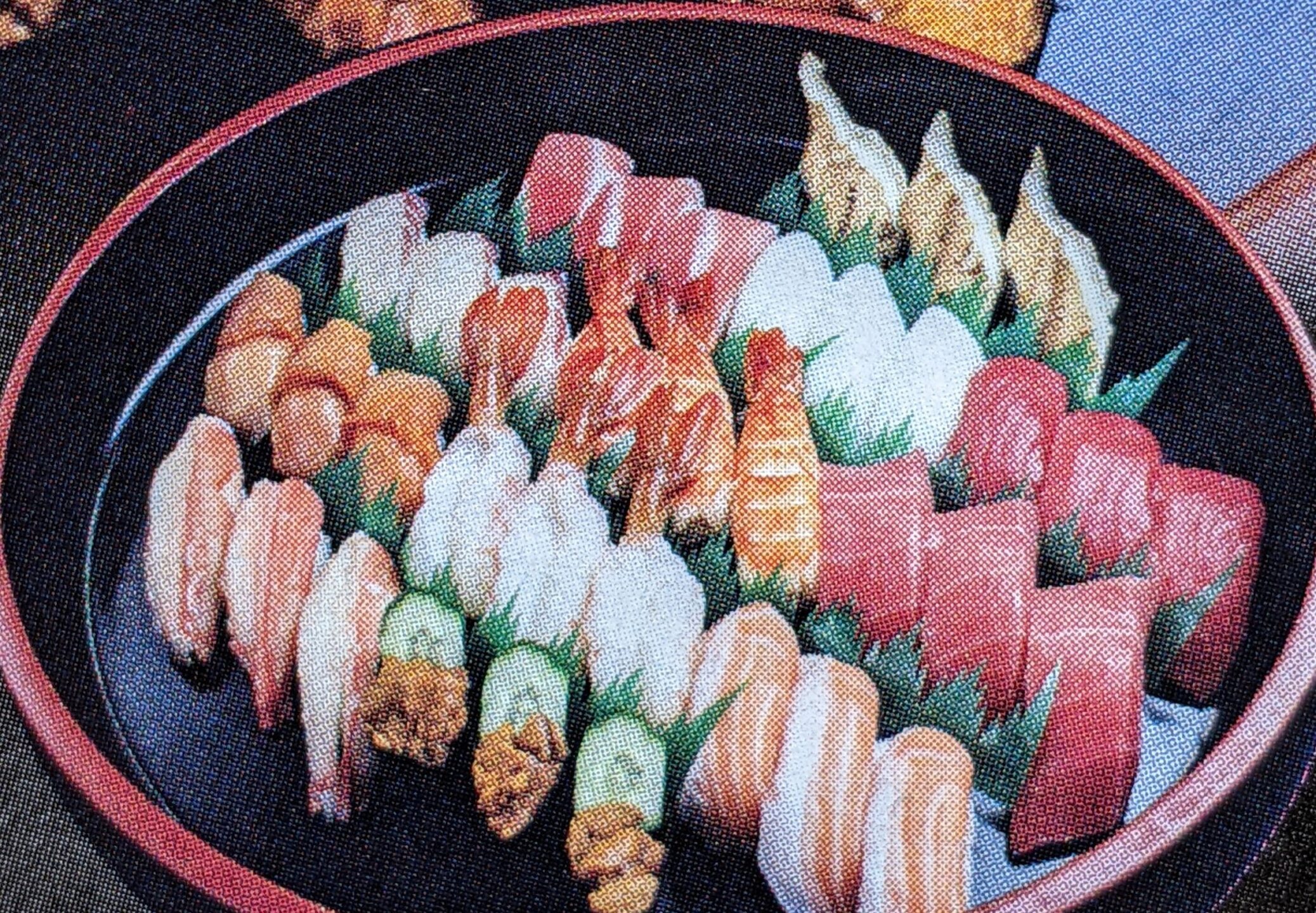
ウナギ屋
ウナギは、かば焼きした後に食べます。
We have eel after sweeten soy sauce boiled it.
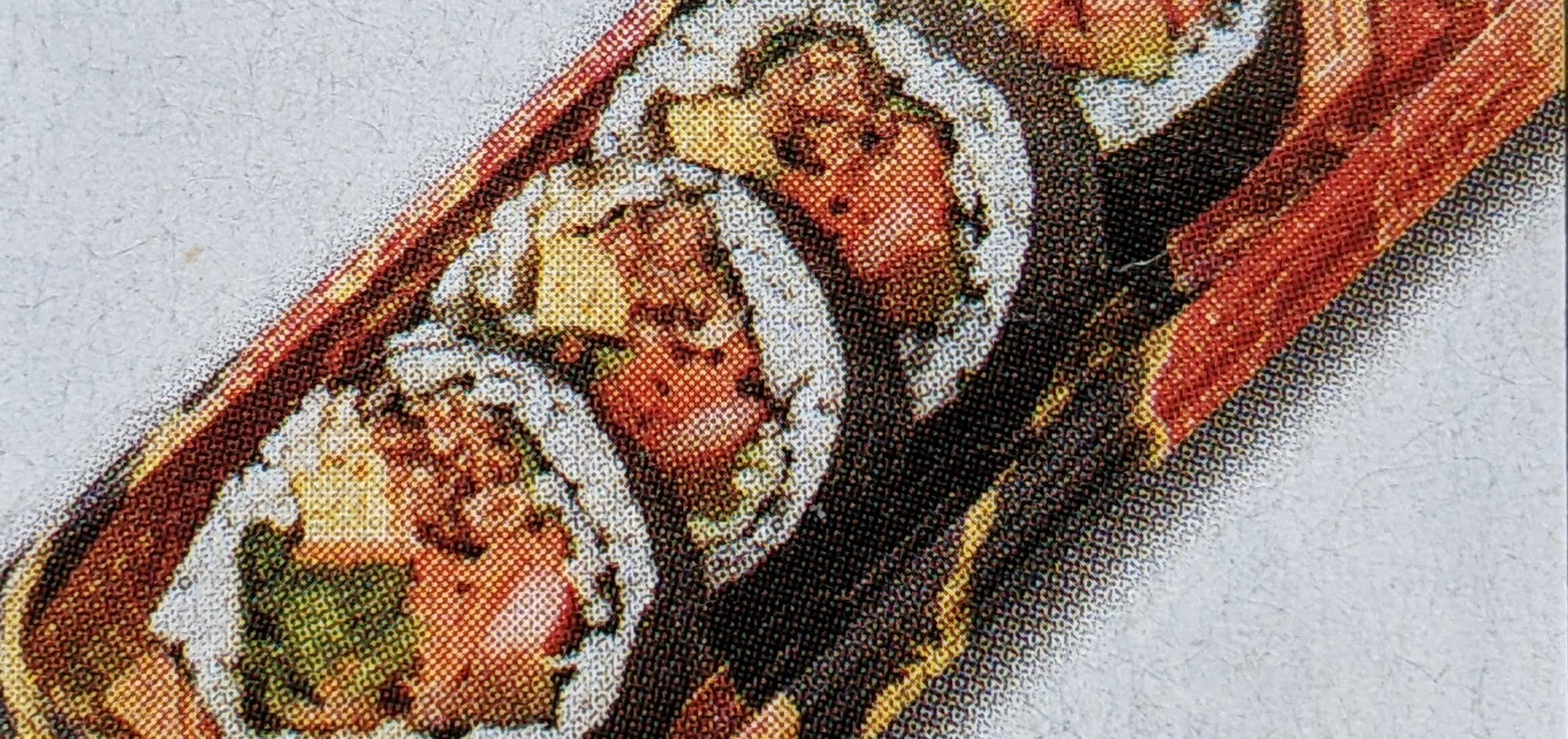 写真:アナゴ巻き(sea eel sushi rolled in dried laver)、refer to the picture.
写真:アナゴ巻き(sea eel sushi rolled in dried laver)、refer to the picture.
例えば、うな丼/うな重/ひつまぶし/アナゴ巻き(refer to the picture)。
For example; eel on a bowl, eel in box, mix the cut eel with rice, wrap chopped sea eel with seaweed.
麺(noodles)
ラーメン(ramen)
・・・ラーメンのスープは通常8時間以上かけて煮込みます。だからあんなにおいしいのです。
For making the soup for ramen, it takes over eight hours in many ramen shops.
だからあんなにおいしいのです。
That’s why it’s really tasty.
・・・それぞれの地域で特色のあるラーメンがたくさんあります。
There are many kind of Ramens, each region has its own characteristics.
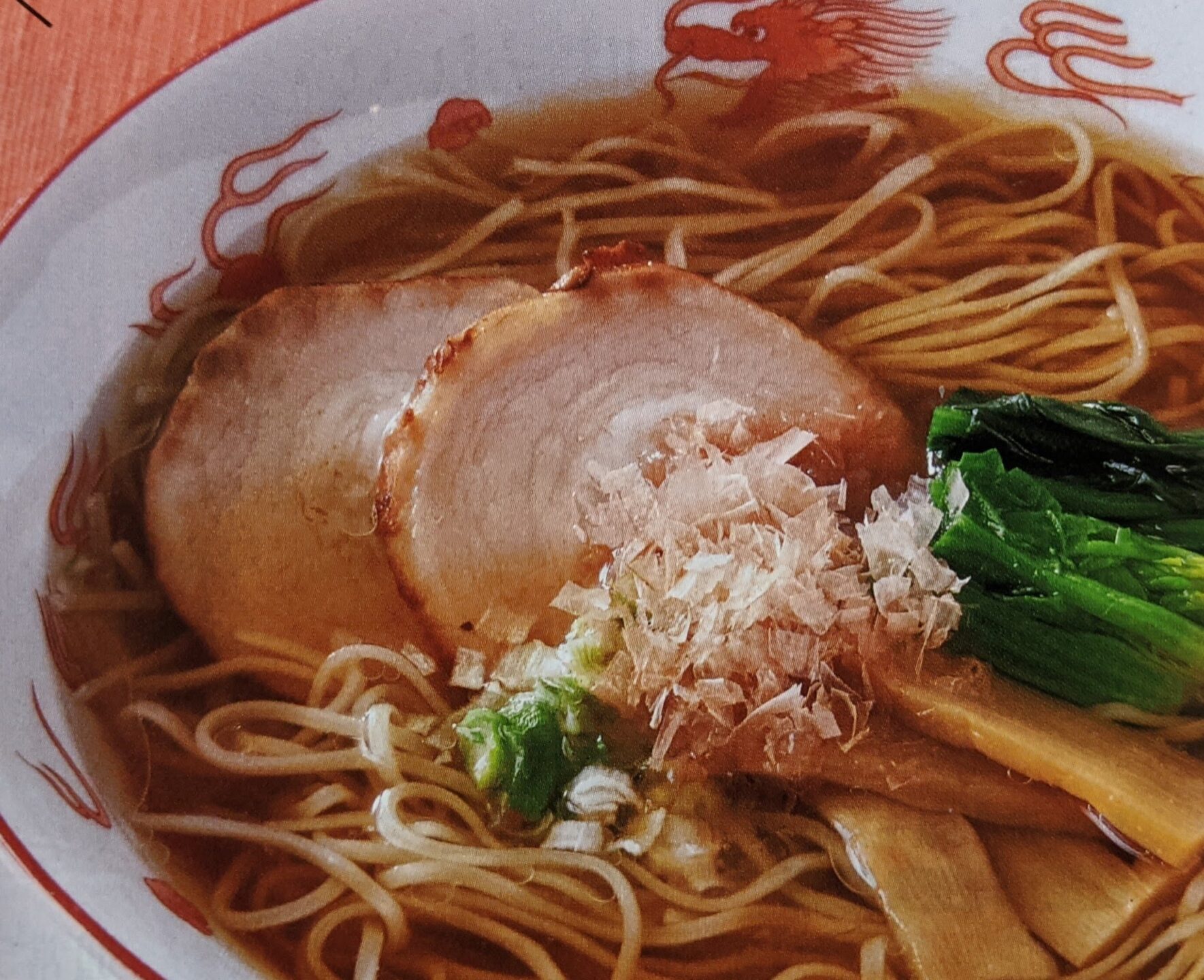
写真:ラーメン(ramen)、refer to the photo. 醤油&鳥ガラ(soy sauce & chicken bones)
だし(Dshi=soup stock)、豚骨・醤油・塩バター・魚介・鳥ガラ。
For example; pork bones, soy sauce, salty butter, sea food, chicken bones.
ちゃんぽん(champon )
ちゃんぽんは、肉と野菜を煮込んだ料理です。長崎地方のめん料理の一つです。
Champon is stewed with meat and vegetables, It’s one of the noodles dish for Nagasaki.
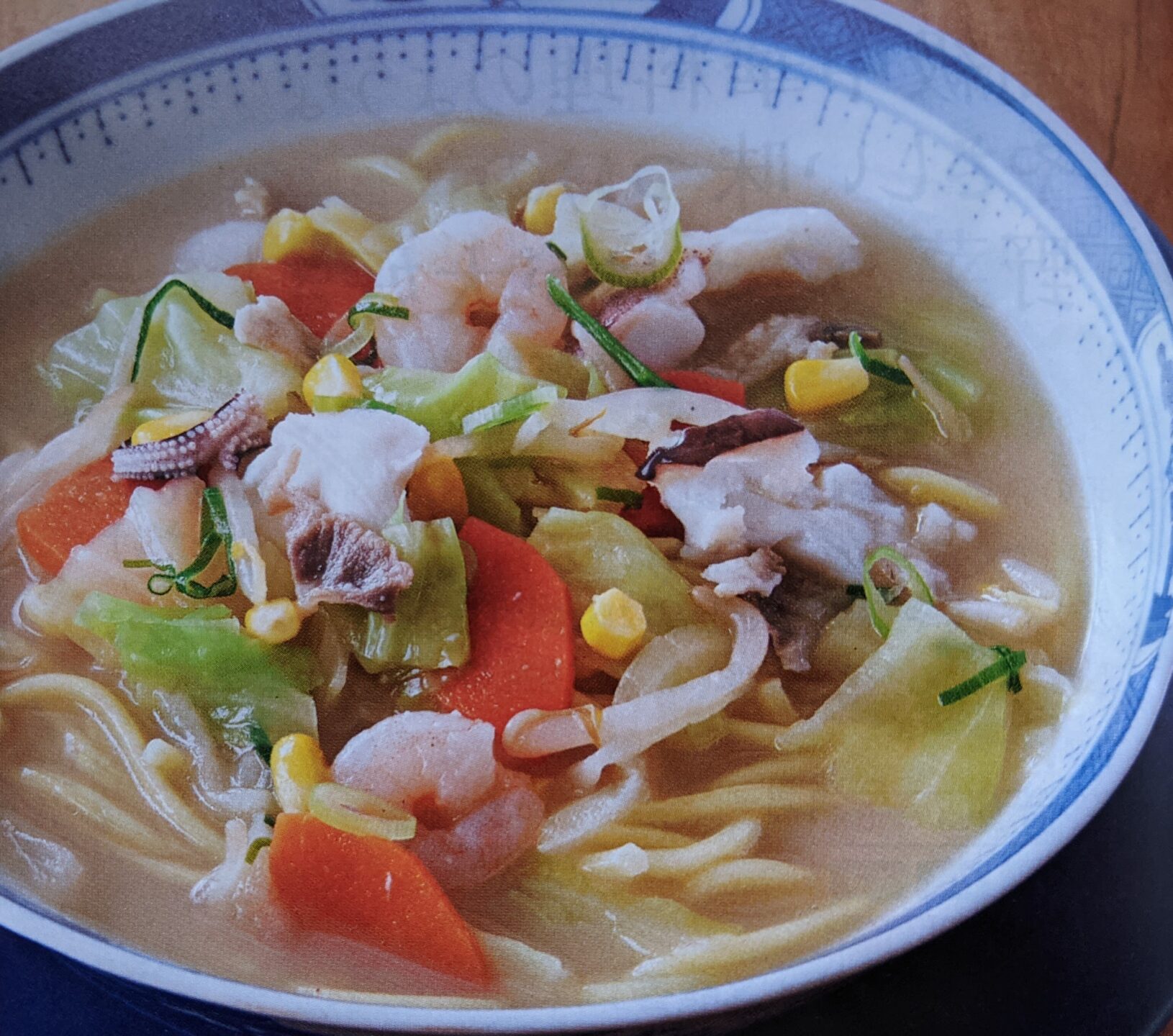 写真:ちゃんぽん(champon)、refer to the picture.
写真:ちゃんぽん(champon)、refer to the picture.
そば(buckwheat)
・・・日本のそばは、音をたてながらすすって食べるのが粋です。
It is chic to make slurping sounds while sucking down Japanese buckwheet noodles.
食べ方、そばつゆ(sobatuyu)につけてから食べる。
how to eat=after being dipped in a cold sauce.
例えば、ざる(zaru-soba)・天ぷら(tempura-soba)。
For example; cold soba on the bamboo colander, tempura is served separately.
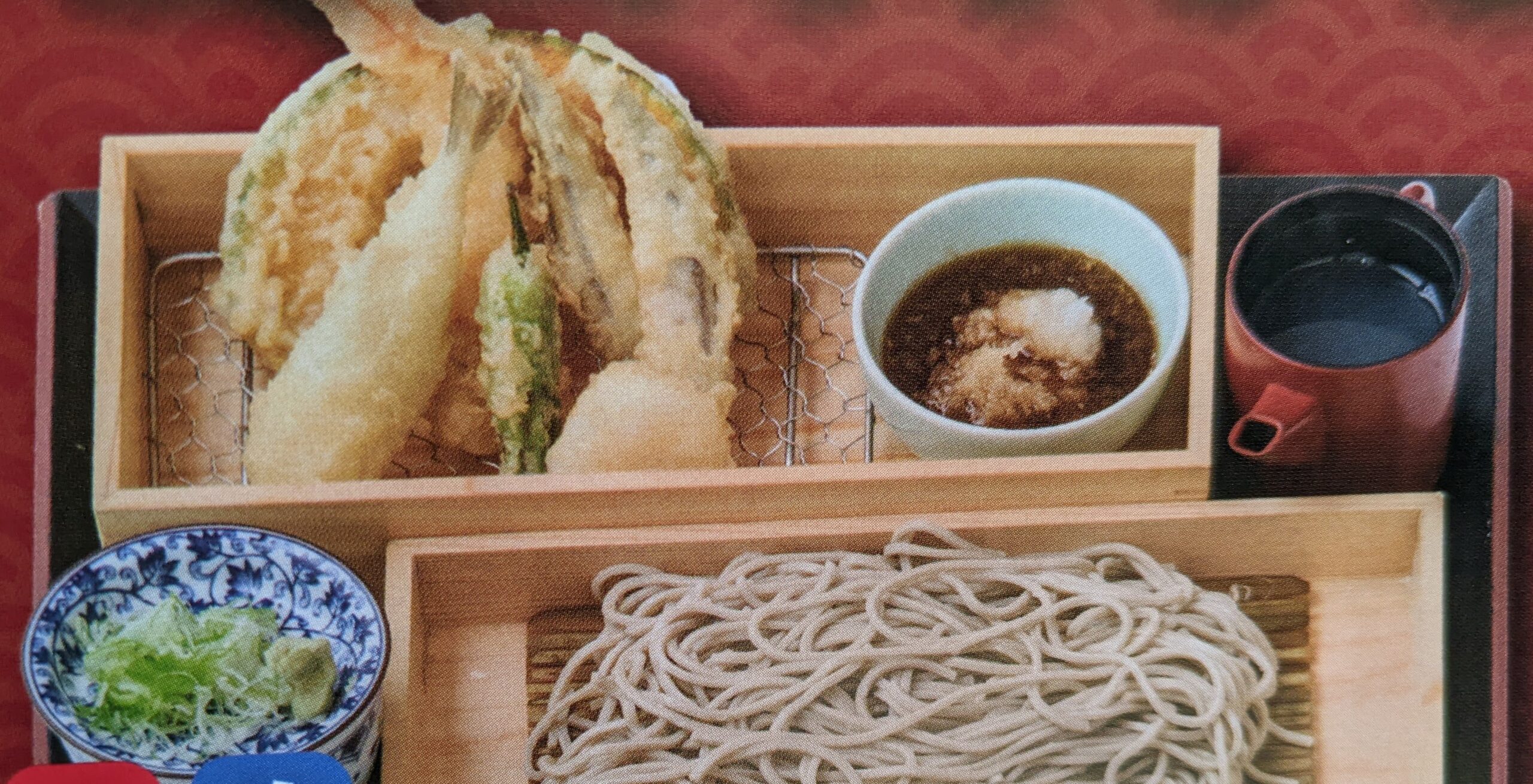
写真:天ぷらそば(tempura-soba)、refer to the picture.
天ぷらは16世紀ごろに、キリスト教と同じくポルトガルの宣教師らから伝わったといわれています.
Tenpura is a dish that, like Christianity, was originally introdused to Japan around the 16th centry by Portuguese missionaryies.
食べ方、どんぶりで食べる
how to eat=put eat Soba in a bowl.
例えば、月見(生卵)・狸(たぬき)
For example; raw egg, deep-fried scraps.
年越しそば
日本には年越しそばという習慣があります。
We have a custom of year-crossing soba noodles in japan.
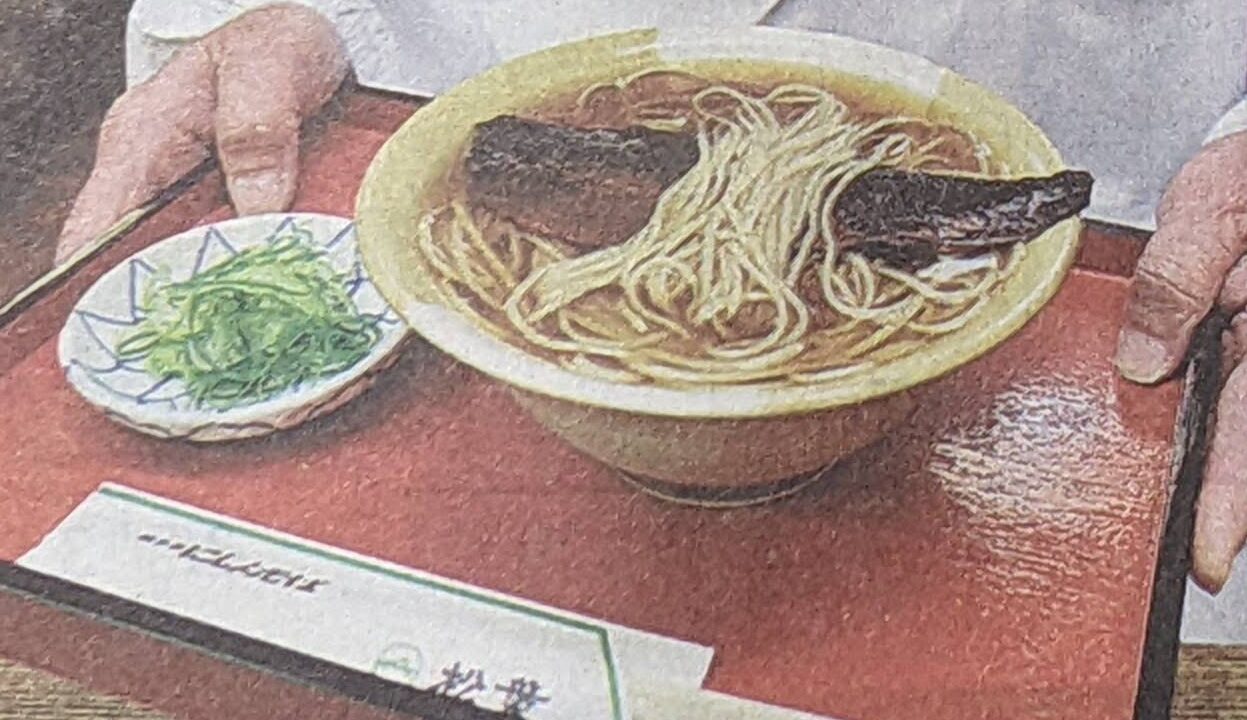
写真:京都を代表する、にしんそば(Soba noodle Soup with Herring=represents Kyoto)。
うどん(Udon=thick white noodle)
食べ方、どんぶりで食べる
how to eat= Udon eaten with a bowl.
例えば(put on the Udon)、天ぷら・月見・狐(きつね)・狸(たぬき)。
For example; tempura, raw egg, deep-fried sliced tofu, deep-fried scraps.
きしめん(Kishimen=flat wheat noodle)
食べ方、どんぶりで食べる
how to eat= Kisimen eaten in the same way as Udon.
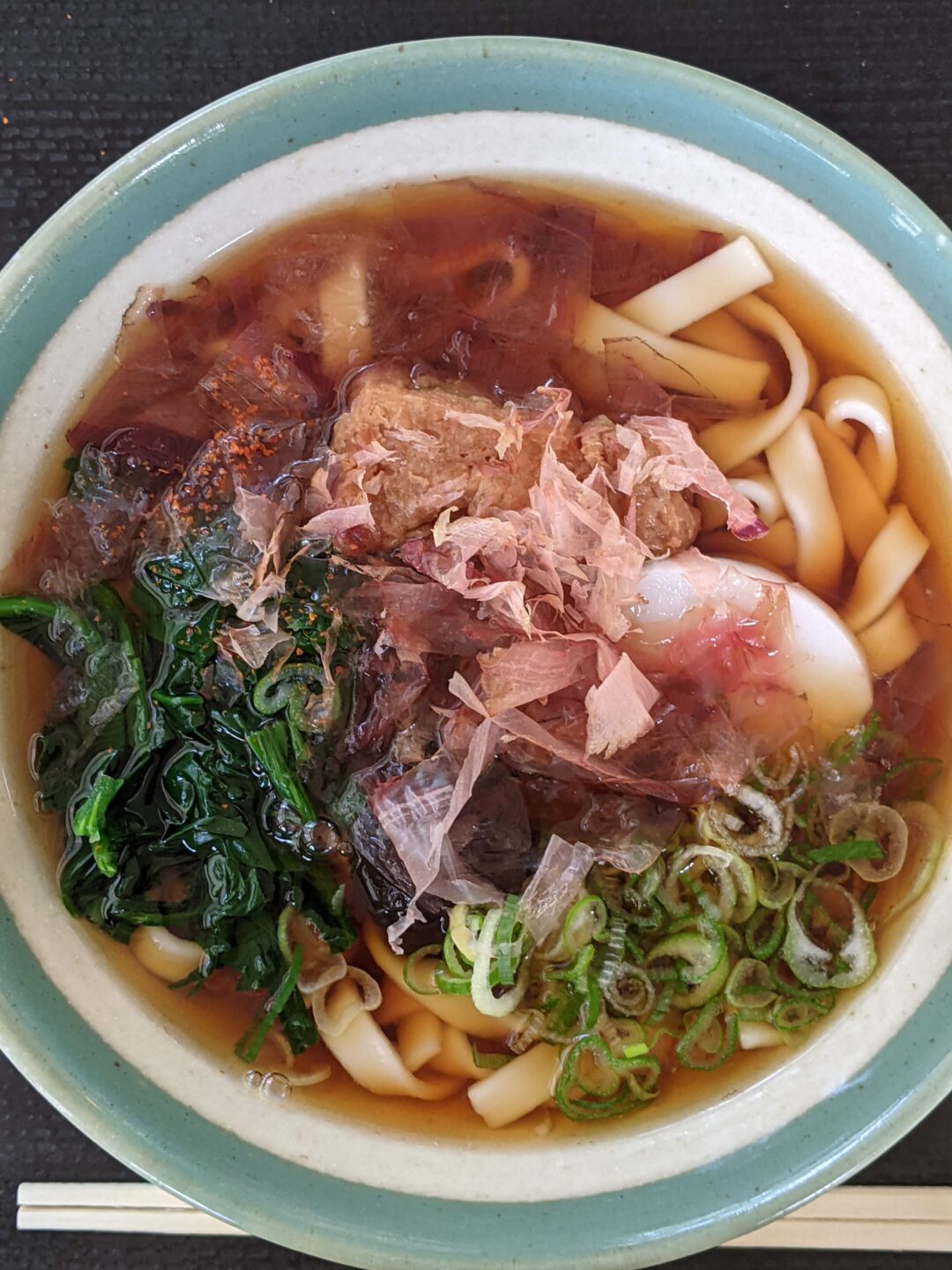
写真:きしめん(kishimen=flat wheat noodle)、at Atsuta shrine。(There are many kind of menu.)。
例えば、とろろ・エビフライ・かき卵など
For example; grated yam, deep-fried shrimp, beaten egg and others.
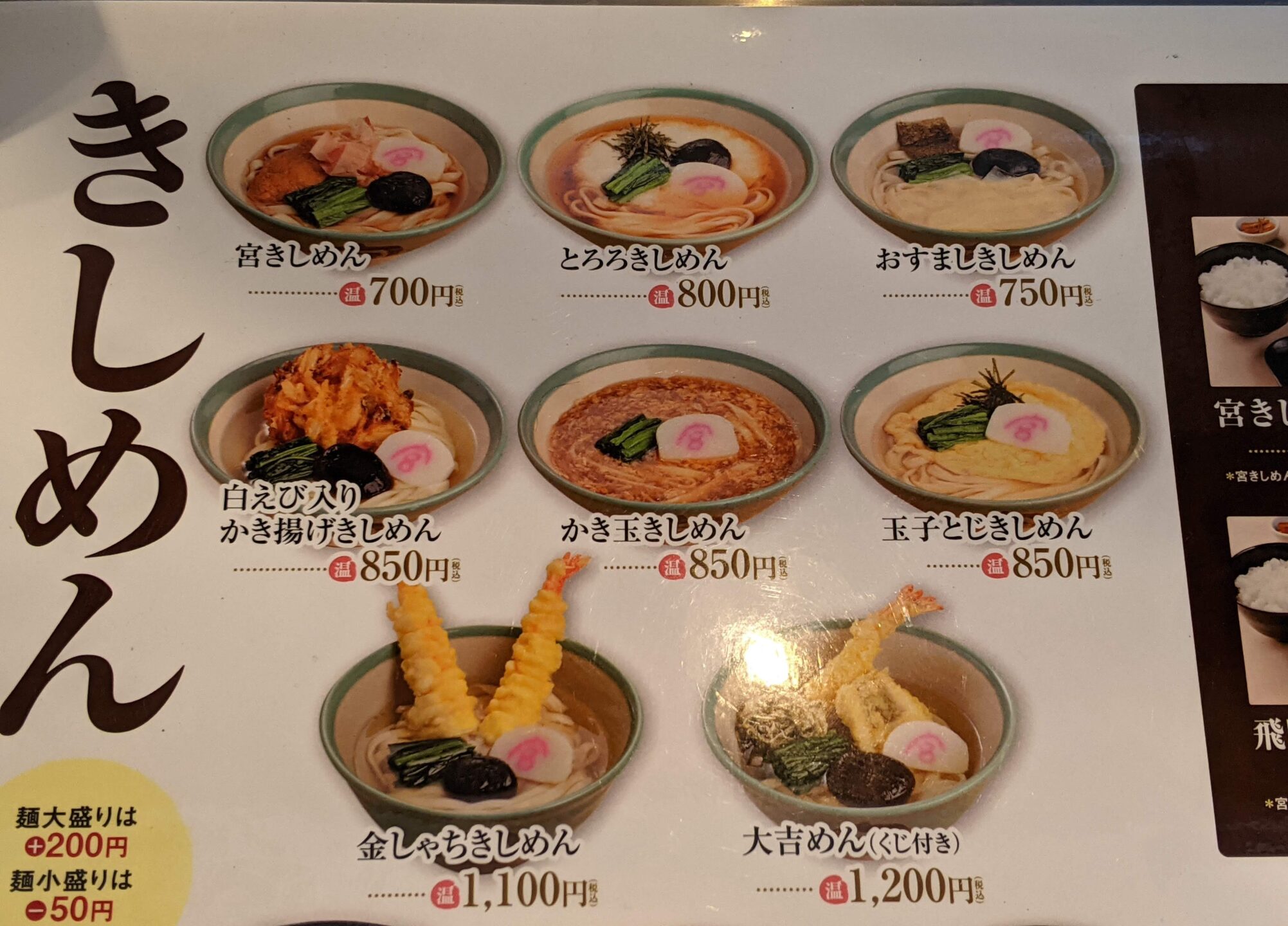
写真:宮きしめんメニュー、at Atsuta shrine
そうめん(Soumen=thin wheat noodle)
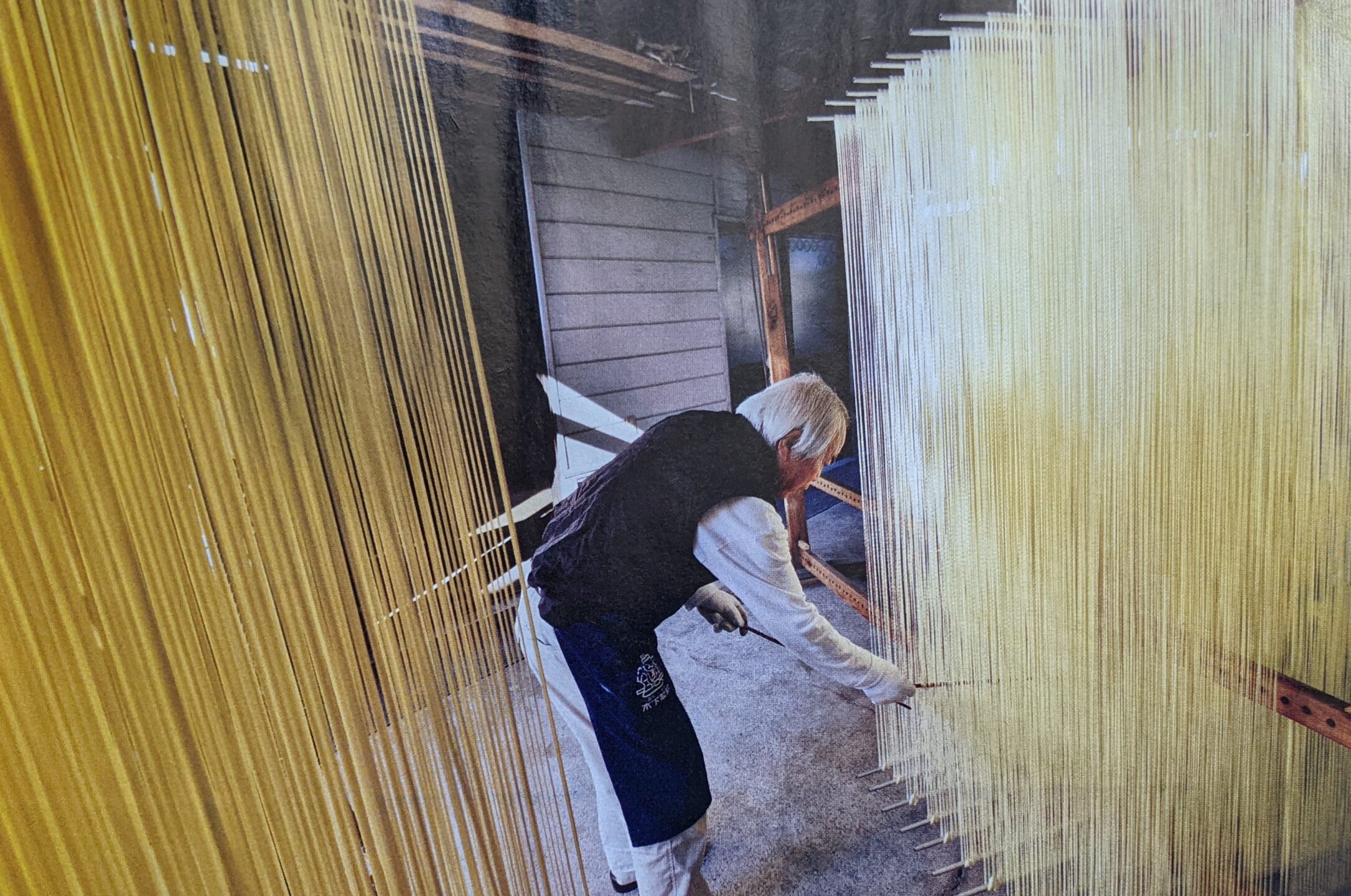
写真:at last, thay stretch it to about 1mm.
そうめんは夏に人気の食べ物です。
Soumen is popular as a summer food.
農家の副業として、冬に作り始めます。梅雨の終わりまでに熟成させます。
As a side job of farmers, they start to make them in winter.
つゆの終わりまでに熟成させます。
It is matured by the end of the rainy season.
鍋料理(nabe=one -pot dish)
・・・鍋料理の概要=Overview of one-pot dishes.
テーブルの上で一つの鍋の中でする料理、煮たったスープのなかに薄く切った肉を入れ醤油ベースのソースで食べる
one-pot dish made at the table by cooking vegetables and slices of meet in boiling broth and eaten with a soy-based sauce.
肉の代わりにさかな類、うどんに卵を入れても出来ます。
You can use fish or Udon and raw egg instead of sliced meat.
一人鍋(one man nabe)も人気があります。
Nabe that you eat alone is also popular.
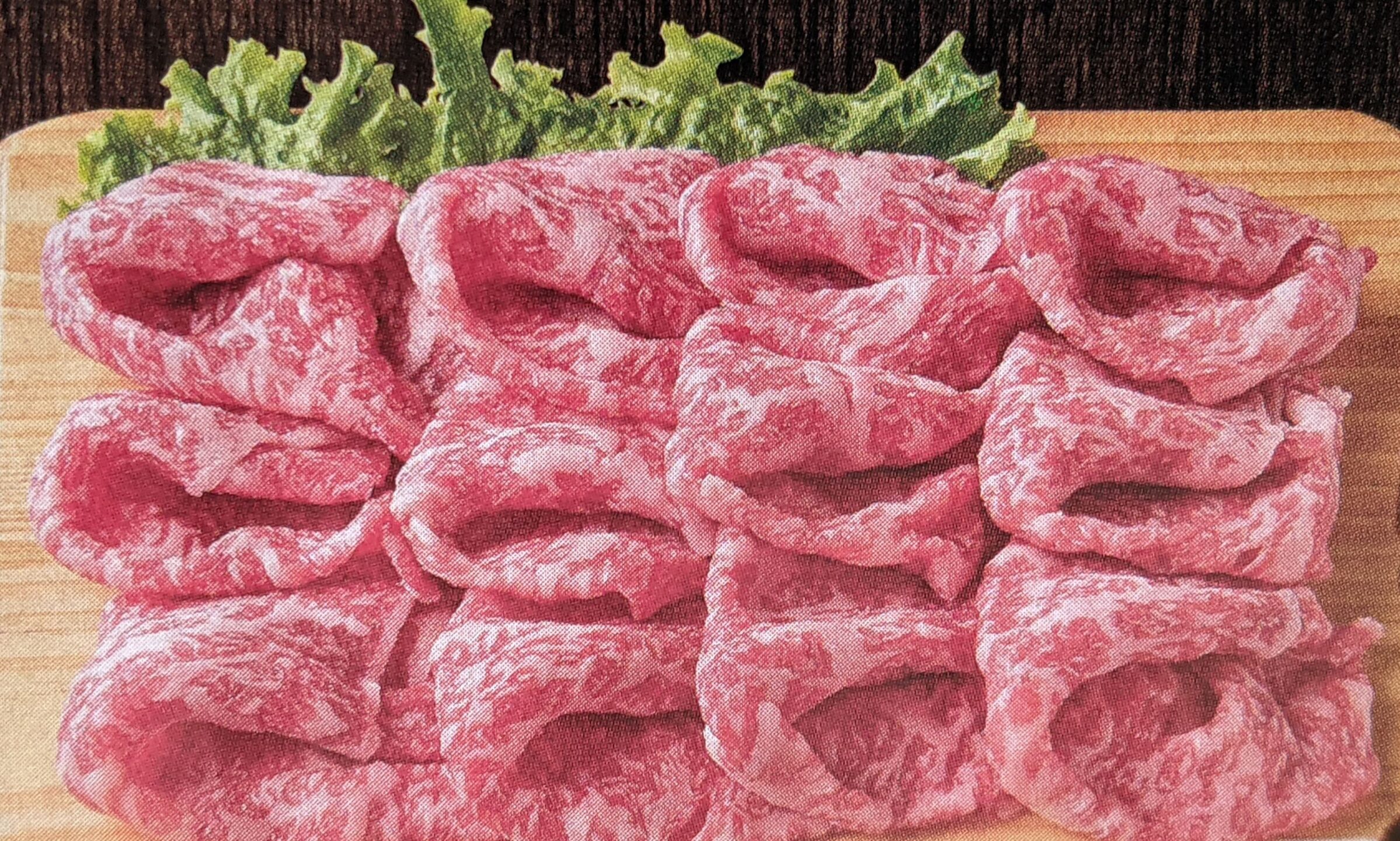
写真:しゃぶしゃぶ用の肉(shabushabu=slices meet)
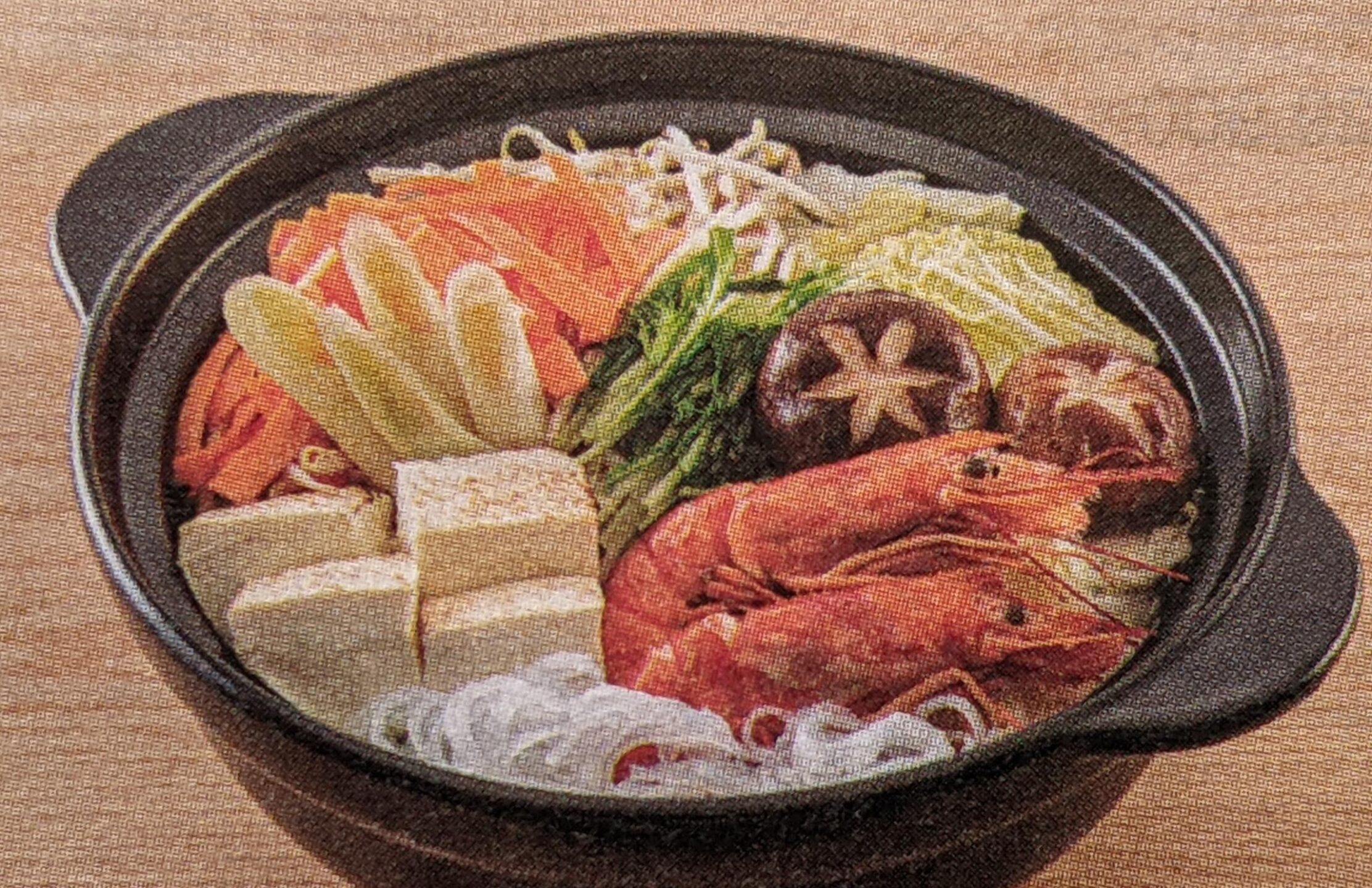 写真:しらたき・魚介(shirataki &sea food=strings of konnyaku)
写真:しらたき・魚介(shirataki &sea food=strings of konnyaku)
例えば、しゃぶしゃぶ/すき焼き/しらたき/魚介/すっぽん/ふぐ/ほうとう/きりたんぽ/山形のいも煮
For example; shabushabu, sukiyaki, shirataki, see food, soft-shelled turtle, globefish.
まとめ
日本食と言えば、とても多くの食材を使いたくさんの種類の料理があります。
Speaking of Japanese foods, there are many kinds of dishes and so many ingredients.
日本食が食材に恵まれている原因は、海に囲まれ海流に恵まれ、はっきりした四季があるからです。
The reason why we are blessed with ingredients is because we are surrounded by the sea.
I think the four distinct seasons in Japan have an effect on cooking.
もう一つ重要なことは、伝統的な日本食を守り調理法・味付け等、修行に励む多くの料理人が存在していることだと思います。
I think one more important thing is there are many cooks who protect traditional Japanese food and practice cooking method seasoning.
そして料理人には、基本的に他人においしいものを提供しようとする心構えが存在します。
They basically has attitude to serve delicious food to others.
そのために努力と時間をおしまない、彼らの国民性に敬意を払い感謝します。
In order to do so, they spare no effort and time, I respect and appreciate the national character.

写真:お祝い寿司弁当(Sushi bento for celeblation)最後までご覧いただきありがとうございました。
